#African bush snake facts
Explore tagged Tumblr posts
Text
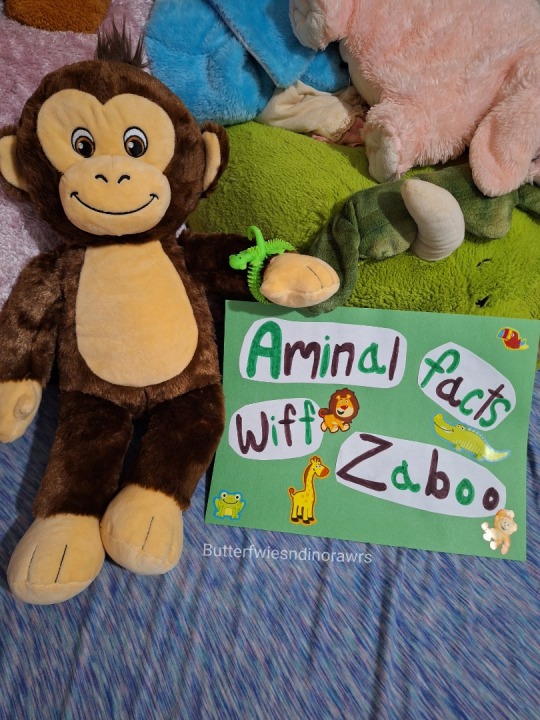
Welcome to Aminal Facts Wiff Zaboo! Part 5
South African Galago!
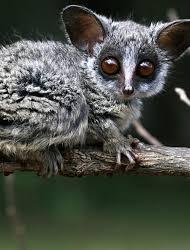
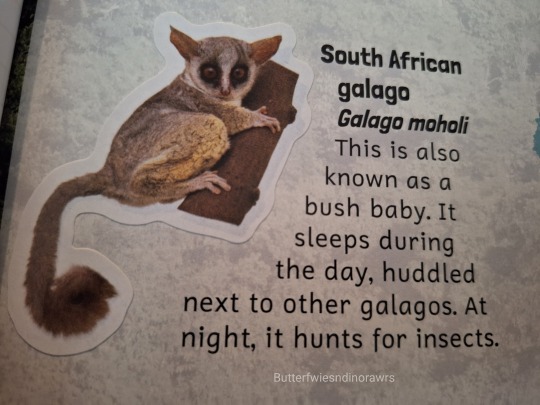
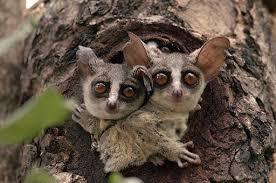
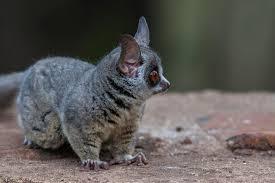

These adowable cuties by many names is also called nagapies which means night monkeys where they're from. Zaboo is excited because dey is primates too! Along wiff their big big eyes dat helps dem see at nights dey has adapted to nocturnal living (ninja monkeys proofs #1 🥷🐒-ninjas go outs at night) wiff little satellite-like ears dat rotate independently to zero in on prey at nights. (ninja monkeys proofs #2 🥷🐒- sneaky stealthy skills for detecting) Dey eats insects which dey catchies in da air wiff dey super quick reflexes (ninja monkeys proofs #3 🥷🐒- ninja reflexes), tree gum n dey favowite is acacia tree gum, fruit n even small aminals like frogs n birbs! Dey grow to be about da size of a large squirrel 6 inches (15 centimeters) in dey body, n dey tail stretchies up to one n a half dey body, about 9 inches (23 centimeters). Dey has a special ability to store energy in dey tendons dat let's dem achieve massive jumpies dat muscles alone could no do... in 4 seconds it can jumpies 5 times to get overall jumpies of 27.9 feet (8.6 meters)!!! (Ninja monkeys proofs #4 🥷🐒- ninja jumpies) Dey has a tooth-comb which is made up of lower incisors n canine teefies dat dey use to grooms n cleans demselves. Dey is social aminals dat lives togeffer in small families of 2-7, sometimes more but dey go hunting alones at night. (Ninja monkeys proofs #5 🥷🐒- lotsa ninjas works alones)... Dey also nose boops! Dey has been seen pressing dey noses togeffer as dey like cuddling n showings affection. Dats just da cutest! 🥹🥰
N finally a final fact...dey get dey nickname bush baby from da various cries, squaks, n grunts dey makes dat sounds like human babies!
Also if yous coulds no tells Zaboo n I is convinced dat these little monkeys is ninjas! 🥷🐒 .. What do yous think?
📢📌🚫🔴🚨🛑
*runs awound hollering n making ambulance sounds*
Alert, alert, ALERT!!! Spookiness aheads, proceeds wiff cautions!!!
📢📌🚫🔴🚨🛑
Now a spooky fact for da spooky loving babies out there, there's a legend dat says dey kidnap babies n da cries you hear are actually da babies... another legend says dey sounds are really mades by a giant snake wiff a feathered head n rainbow colors which kills intruders... to dis day even though da galago is not dangerous to humans it considered a bad omen to hear dem as it means danger or death is near. Now researchers think dis all started as a story to keeps kids indoors at nights but a quick search into dis topic yields a lot of interesting infos.. if yous like da spooky spooks!
#aminalfactswiffzaboo#agere#agere blog#agere little#agere community#sfw agere#age regression#age regressor#agedre#agedre community#agedre blog#sfw agedre#age dreaming#sfw little post#sfw little community#sfw little blog#sfw little stuff#sfw littlespace#sfw age regression#sfw caregiver#sfw regression
19 notes
·
View notes
Note
🐍 <- for the ask game
🐍 : what kind of snake you'd give them
okay I wasn't given a character so I'm just gonna pick which ones... And I say LMK :3 Probably just gonna do the main pigsy's noodles gang, but I might do a follow up post with the villains sometime
p.s. I know next to nothing about snakes so sorry if I get something wrong!!
MK -> "Banana" Ball Python

Look at it!! So cute :3
The reason I chose this one is, obviously, the coloring! It's called the banana ball python so it fits MK ^_^
Ball pythons are often kept as pets too, but there's a lot of color variations!!
Mei -> African Bush Viper

Chose this one cause it looks like a dragon!! Fits Mei the most, for obvious reasons :)
Fun fact, it's also venomous, so I guess it could also fit the Spider Gang
Pigsy -> Pink Corn Snake

Honestly I'm mostly just choosing based on colors there's not really a deeper meaning 😭
Anyways. Pink 👍
Tang -> Golden Brown Crowned Snake

I really don't know what Tang's main color is. Brown? Red? Gold? So here's a snake that's got a little bit of everything :)
#dev's asks#dev answers#ask game#lego monkie kid#lmk#mk#lmk mk#mei dragon#lmk mei#pigsy#lmk pigsy#tang#lmk tang#snakes#tw snakes
8 notes
·
View notes
Note
Snadri (snake adri) is so wonderful and I love fidget snakes with such good shapes and textures. Snakes with keeled scales look like dragons! The variable/african bush viper comes in any color you could imagine and I think you'd like them! Most of the pictures online aren't edited (except that one that you'll see literally everywhere) and they actually are sky blue and purple sometimes.
YEAH!!! Bush vipers are literally so cool and they do come in so many colors
Did you know the blue coloration is actually from lack of yellow pigment?? i believe its a mutation or gene that makes the yellow not appear so they look blue, because actual blue pigment in nature is so so so rare
AND I KNOW THE EXACT PIC YOU MEAN

This one that has been edited literally into every color on earth ... its like a son to me at this point
I love these types of scales though for sure they have been a huge inspiration for me! When I was looking at references for adri for a more snakey look I was also looking at rough death adders for vibes, they ended up becoming a fave snake honestly. They are so goofy looking but so adorable


As for snakes that look like dragons there is also this one which i dont know much about other than the fact it exists but its so dope:


(Dragon snake, or xenodermus javanicus) They have gorgeous scales and the biggest saddest wettest poor little meow meow eyes and faces oh my god. They are downright gorgeous snakes though
#ask#snakes#i love these freaks so much <3#one day i will have a lil guy.................... ouh#id love to have an adder i love their fat bastard heads i wish they were manhandleable but all the snakes with The Cheeks#are dangerous... which is such a shame
34 notes
·
View notes
Note
do you have any favourite hot snakes? obviously not to work with!
PSA for everyone - LEAVE THE VENOMOUS REPTILES TO THE PROFESSIONALS: DO NOT ATTEMPT TO INTERACT WITH VENOMOUS IF YOU’RE NOT SPECIFICALLY TRAINED AND SUPERVISED
Oh man do I. I’ll do three otherwise I’ll be here all day.
Boomslangs! Aka “Dispholidus Typus”.
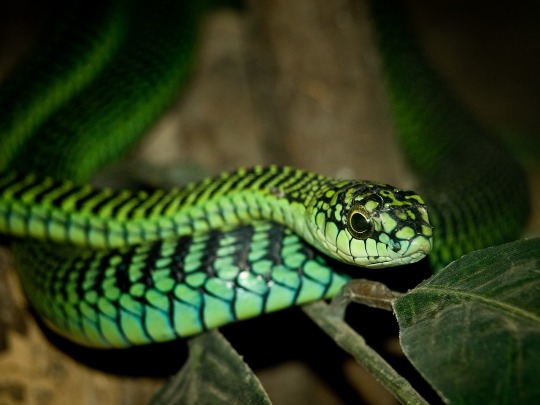
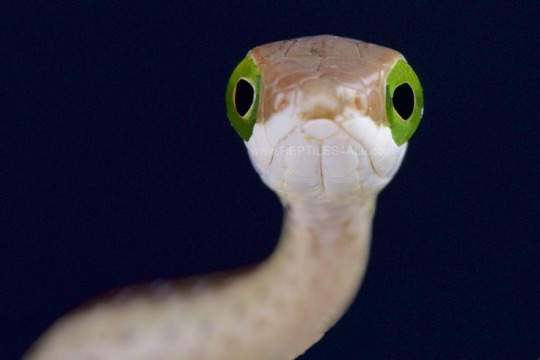
[id: 1 green and yellow boomslang with black eyes, and 1 brown boomslang with bright green eyes]
Liddol guys! Look at their faces! What do you MEAN this cutie could kill me by making me essentially turn into a blood fountain, I don’t believe it. Maybe it’s worth it. They’re so beautiful too.
They’re colubrids (so the same family as kingsnakes, cornsnakes, hognoses etc), and while most colubrids aren’t venomous, there’s a few that absolutely are, and fewer still that can kill you. This particular snake has venom that’s a hemotoxin, meaning it causes just TONS of micro clots, which then makes it so that you can’t clot anymore and you hemorrhage and can start bleeding out of eyes, gums, etc. And it only takes a small amount of venom to be fatal to a fully grown human! Fortunately, all they want is to be left tf alone and biting is a last defence when they’re being harassed.
Samar Cobra “Naja Samarensis”



[id: black cobra with bright yellow markings and hood]
Look I tried to find pictures where they don’t look like an affronted shoelace but they just do. I love most cobras but look at their face. They’re like bro. Can I fucking HELP you. 100% is supported by the fact that they’re sketchy as fuck, if you look at them wrong they’re like you know what buddy, I’m gonna spit my venom at your eyeballs.
They’re elipads* that are indigenous to the Philippines, and despite being skeeved out by humans they like hanging around places like rice fields because it’s where things like rats like hanging out. Their venom causes a delightful number of effects like paralysis, respiratory distress, and necrosis if bitten, and if you’re unfortunate enough to get it in your eyes after being spat at, it can cause blindness as it wrecks your eyeball tissue. Fun!
* elapidae - snake family that have permanent fangs out, like this dude below, a king cobra that’s found their home at the St Augustine Alligator Farm in Florida!
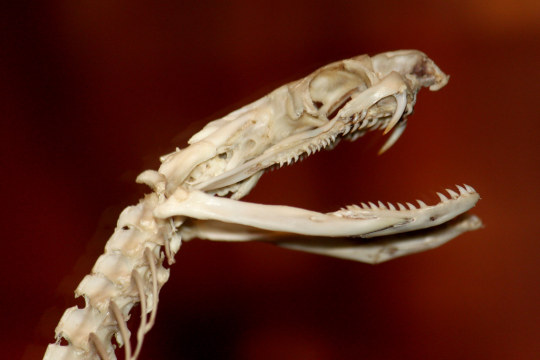
[id: skull of a king cobra]
Bush vipers!


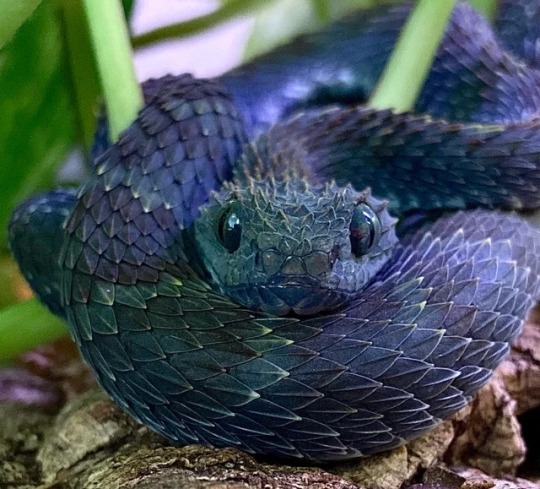
[id: 3 types of bush vipers; a brown and orange tia hairy bush viper, a bright green west African bush viper and a dark blue variable bush viper]
I can’t even choose a subtype. They’re legitimately one of my absolute favourite types of snake. I would kill I would DIE to be in the presence of one. They’re mini dragons! Mini extremely venomous dragons!
They’re from the viperidae family, which contain over 200 types of viper. Like the elapidae family, they’ve got fangs at the front and venom glands stored in their heads. Viperidae fangs are foldable back in their mouth rather than constantly having them locked to the front like elapidae, and viperidae fangs are longer, and there’s differences in the types of venom they have too. They also have one lung!
Bonus: gaboon viper. What is this. Ridiculous animal. He is TRUNDLING. Chugga chugga of death.
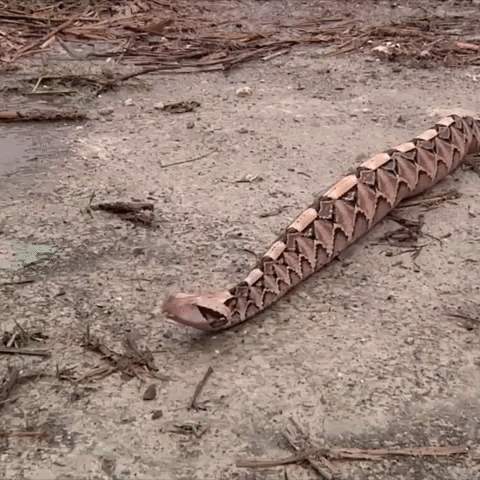
#I got too into this#juniper posts#adhd hyper focus strikes again#I learned a lot by researching while I was writing this thanks anon
54 notes
·
View notes
Text
COOL AND FUN DONNA AND TRIXIE FACTS BC I HAVE BEEN LAZY AS HELL ON THIS BLOG OOPS (pspsps @goobersforlife late propaganda,,,,)
Donna is part snake! Specifically part African bush viper, their scales look super cool lol, look em up
Trixie comes from a very rich family that owns a titanium mine. Her family is secretly involved in criminal activity that she was kept in the dark about, and she ends up betraying her family for the turtles
Donna uses a lot of venom darts, most of which are hidden in her bo via cool secret compartments. She's more of a biologist/chemist than a mechanic, that's Raph's thing, so you really wouldn't expect a wooden stick to pop open to reveal poison darts lol
Trixie is a huge entomology nerd!! She loves bugs and arachnids, and thinks the way people treat them is fucked up. They're just little animals, there's no reason to kill them just cuz you think they're "yucky". Fucking asshole, c'mon. Grow a heart you loser.
5 notes
·
View notes
Text
Phinda. 4:48a.
I don’t have much time, but I’d love to share some of what I’ve done the last few days.
I believe I left off with &Beyond. Well today, I sit at an &Beyond location — Phinda Game Reserve — which is located in eastern South Africa. More on that momentarily.
Two days ago we went to Soweto. It was the type of experience that I had hoped for. Something true as opposed to the luxury malls and hotel. Soweto has approximately 3 million people. It’s a suburb of Johannesburg. It stands for “southwestern township.” As you pass the “welcome to Soweto” sign by vehicle, you begin to snake through streets and, generally, descend deeper into the valley. One side of the street tends to be where the “haves” — 4 room house, higher fences, barbed wire, electric fences — live while the other is where the “have nots” — 3 rooms, more run down, etc. — call home. As you descend deeper into the belly of Soweto, the homes get worse. We saw several stray dogs that looked okay — don’t worry Al! — but not in ideal shape. We eventually progressed into an “unincorporated” part of Soweto. Those who live there — ~46,000 — are considered squatters, but most of their families have lived there since 1901. This area is extreme poverty. No running water. Literally 20 families share a single portapotty. We toured one home, which consisted of 3 rooms that are shared by 26 family members. I am not exaggerating. The home’s roof was tin, its floors dirt. As we carved through the village’s alleyways, we stumbled upon thick, uneven rocks and putrid trash that were floating atop a light stream of running water. The water smelled of human waste.
I am sorry to be graphic, but it is important. It was the experience that I had been waiting for, because it’s a real experience of South Africa. I can think of no better way to complement my current time in the 5-star luxury lodge of Phinda than to spend time in the deepest slums of Soweto.
What have I done to deserve such fortune? So much of my current station is due to where I was born and from whom I was born from. Yes, I believe that I have worked hard, but the ingredient that’s played the featured role is luck. Had I been born in Soweto, for example, no hard work would have gotten me remotely to this point in life. Ruminating on these facts only help so much, though. I’m a big disciple of Stoicism, which one of its primary tenets is that there are things that one can control and others that one cannot. The things that I can — effort, mindset, education, discipline, generosity — are where I should dedicate my time and focus. The others — luck, macro events, etc. — I should not, because I can’t control them.
Phinda. It is magical. Perhaps the best way to summarize it to the audience I have is that it’s an oasis that would receive a hearty stamp of approval from mom. Yea, this even remains true despite the fact that it’s in the middle of the bush, surrounded by all the iconic African predators.
We’ve seen lions, elephants, cheetah, giraffes, wildebeests, warthogs (and 3 piglets), white rhino (which is exceedingly rare in Africa), African buffalo, terrapin, tortoise, zebras, impalas, nyalas, the little bird that’s always with Poomba and Timon, a jackal, and as of last night, a hippo, crocodile and leopard! We await the hyena, wild dog, and the honey badger, with others I’m sure, too. To find the honey badger would be like finding the rarest Pokémon.
I could go on about the service at the lodge, and please let me know if you’d me to write about it, but I will hold off on that for another time. Think upon arrive, a hot, damp lemongrass towel to refresh your face. Flavored, homemade pineapple syrups combined with sparkling waters to quench your thirst. Homemade shortbreads and cookies with coffee, tea and hot chocolate — all consumed not just anywhere, but in the middle of the bush, halfway through our early morning safari and late night rides. The latter pit stop of which is known as a “sundowner.” At night, I walk back to my room, which I cannot do unattended because of the danger. During the day, when I walk to my cavitation, I see nyala awaiting my arrival, literally 8 feet from my door.
It’s a perfect experience that makes me think of family again and again. I hope that we can share something like this in the near future.
Taking a brief step back, I want to try to give some big picture thoughts.
If one can afford an experience such as this — and it’s far from cheap — then I can’t think of anything much better. It’s an education that cannot be duplicated, so long as it is accompanied with a real-world experience of the local community, too. No trip should be exclusively this, because it distorts the reality of the struggle that so many in this country face. Nathi — the taxi driver who picked me up when arriving into the country — would not be able to do this, despite working his tail off and possessing such a powerfully positive mindset. I owe it to myself and to others to ensure that I don’t lose track of this appreciation and channel it towards something true and good.
As mentioned, this also makes me think of family. I know that I’m in the right head space when my mind continues to return to you guys while I’m here. I want to share the experience with you all rather than keep it to myself. Hopefully it does not come off as gloating or inconsiderate. Moving forward, get ready for an annoying Pierce who will be peppering you at holidays, angling for a family trip abroad such as this.
Regarding affordability, as mentioned it’s far from cheap. Truly far. However, it’s a reminder to me to say no to certain things in life — including multiple other trips — so that I can use a high concentration of funds on something like this. “This” is luxury, combined with education, nature, while also ensuring I see the other side of luxury — the reality of places like Soweto. It also channels my mind and gives me purpose to work harder to earn more money so that I can tether that towards something like this — especially in teaching lessons to my children. Finally, it’s money spent towards something good. The money that’s poured into this place directly benefits wildlife conservation, the people who live in the villages around us, etc. It’s a more virtuous form of tourism.
I’ll end with the following: Poaching v Pineapples. What does greater damage to African animals?
Poaching has led to animal extinction in places throughout Africa. Pineapple farms decimate entire ecosystems. Poaching may remove the black rhino in Phinda, but pineapple farms wipe out all flora and fauna in pursuit of the mass production of pineapple. That means no lions, elephants, leopards, etc. It also means fewer insects, flowers, trees. A poacher can be dealt with, pineapple farms cannot beyond ensuring that don’t exist. Of course, I’m not iconoclast against pineapple — it’s a a good thing! It’s just being mindful of the ecosystems that it is wiping out. In places such as this, no pineapple is worth what it’s replacing. What’s the pineapple farm equivalent in SD and MN?
Thinking of you guys!
-Pierce
0 notes
Text
ADDENDUM^3
Recently, I started reading Jeffery Anderson’s Voodoo: An African American Religion. Published in 2024, this probably contains the most accurate information about the historical, New Orleans Voudou pantheon (as in, pre-revitalization)
Really interesting book! It might take me a while to finish it…
Some things of note:
Anderson proposes several different origins for the deity Assonquer, arguing that the most likely origin is the orisha Osanyin. One of the alternative theories suggests he is derived from Ossange, described as a lwa with healing powers of the Ogou family.
No mention of Maitre Carrefour. He was either worshiped in secret, or the refraction Fon Legba into the lwa Papa Legba and Kalfou (Maitre Carrefour) was never transmitted to New Orleans. Notably, Anderson describes how the historical, American Papa Legba (“Papa La Bas”) was demonized, where an interview from 1940 equates him with the “devil”. In fact, this seems to be why his name is recorded as “Papa La Bas”; “La Bas” meaning “Down There”, as in “The Devil”.
Previously, I named the Damballah-inspired character “Sir Duke” / “Grand Serpent”. This needs to be changed to “Grandfather Serpent”, or “Grandfather Python”. Damballah is probably associated with Grandfather Rattlesnake, not Grand Zombi. I’m probably going to rename him “Grandfather Python”, to emphasize that he is not a venomous snake. (I gave him fangs for the sake of anime battles and making him look cool, but there is no venom in his fangs… they are just very sharp…) Actually, I’m going with “Grandfather Serpent”, since he’s not specifically a python. Just a giant, magical, non venomous snake!
One of the most important Haitian lwa is Ogou Feray. He appears in the historical record of the American South under the name “Joe Feraille”. He must have come from Haiti through the port of New Orleans, but it is unknown if he was worshiped in New Orleans specifically.
Rather than the Ezilis, there is some evidence that Lasirèn or Mami Wata was worshiped.
With regards to the second note, here is the full quote from Anderson:
“According to FWP information [sic], Alexander Augustin, celebrants would make circles in the water near Spanish Fort and throw food into the lake. The purpose, as he understood it, was to thank Papa Le Bas [sic], whose name Augustin or the FWP worker translated to mean “the Father below” and whom the informant interpreted as Satan.”
Source: Anderson, Jeffrey E. Voodoo: An African American Religion. LSU Press, 2024, p.
The interview he is referring to is found in the Federal Writers Project: Alexander Augustin, “Marie Laveau,” interview by Henriette Michinard, 15 August 1940, transcript, Northwestern State University of Louisiana, Watson Memorial Library, Cammie G. Henry Research Center, Federal Writers’ Project, folder 25.
I think I found the quote from the interview Anderson described:
Alexander Augustin remembered some of the tales of old people which dated to the era of the Widow Paris.
“They would thank St. John for not meddlin’ wit’ the powers the devil gave ‘em,” he said. “They had one funny way of doin’ this when they all stood up to their knees in the water and threw food in the middle of ‘em. You see, they always stood in a big circle. Then they would hold hands and sing. The food was for Papa La Bas, who was the devil. Oldtime Voodoos always talked about Papa La Bas. I heard lots about the Maison Blanche. It was painted white and was built right near the water wit’ bushes all around it so nobody couldn’t see it from the road. It was a kind of hoodoo headquarters.”
Source: Tallant, Robert. Voodoo in New Orleans. 1946. Reprint, Gretna, La.: United Kingdom, Pelican Publishing Company, 1983. pp. 65-66
I should note, Robert Tallant himself is infamous for his inaccurate, racist descriptions of New Orleans Voodoo.
If you were unaware, the phrase “La Bas” (Là-Bas) used to mean “Down There”, and was historically associated with the Devil. Hence, the title of French writer Joris-Karl Huysmans’ novel Là-Bas (1891), which deals with the subject of Satanism. Over time, the meaning of “La Bas” (Creole: “la ba”) shifted to simply mean “Over There”.
There are two other noteworthy interviews in Tallant’s Voodoo in New Orleans.
The first is the 75-year old “Mary Ellis”, born in 1863 (Alexander Augustin’s age is not specified). Papa Legba is associated with St. Peter. However, his name is recorded as “Laba”, the same pronunciation as “La Bas” (“Down There”, as in “Devil”):
Mary said that most of the things she knew about Marte Laveau had been told her by an aunt who had been a Voodoo.
“My aunt told me one time she had trouble wit’ her landlord. He told her to git out of her house or he’d have her put in jail,” Mary said. “He even sent a policeman after her. The next day she went to Marie Laveau and she told my aunt to burn twelve blue candles in a barrel half full of sand. She done that and my aunt never did have to move and she never went to jail in her whole life. Marie Laveau used to tell people not to burn candles in church ’cause that gived their luck to somebody else, so they burned ’em in her house instead. She’d tell my aunt, ‘If you gonna fool ’em, fool ’em good, Alice.’ She was real good to my aunt. She even taught her a Voodoo song. It went like this:
St. Peter, St. Peter, open the door,
I’m callin’ you, come to me!
St. Peter, St. Peter, open the door …
“That’s all I can remember. Marie Laveau used to call St. Peter somethin’ like ‘Laba.’ She called St. Michael ‘Daniel Blanc,’ and St. Anthony ‘Yon Sue.’ There was another one she called ‘On Za Tier’; I think that was St. Paul. I never did know where them names come from. They sounded Chinee to me. You know the Chinee emperor sent her a shawl? She wore it all the time, my aunt told me.”
Source: Tallant, Robert. Voodoo in New Orleans. 1946. Reprint, Gretna, La.: United Kingdom, Pelican Publishing Company, 1983. P. 103
This “Mary Ellis” is Mary Washington, and this interview can be found in the aforementioned folder 25 of the Federal Writers Project.
The second is the 87-year old “Josephine Green”, born in 1853. Here, Papa Legba (called “Papa Limba”) is again erroneously identified with “the devil”.
Josephine Green, an octogenarian, recalled her mother’s stories about Marie Laveau.
“My ma seen her,” Josephine boasted. “It was back before the war what they had here wit’ the Northerners. My ma heard a noise on Frenchman Street where she lived at and she start to go outside. Her pa say, ‘Where you goin’? Stay in the house!’ She say, ‘Marie Laveau is comin’ and I gotta see her.’ She went outside and here come Marie Laveau wit’ a big crowd of people followin’ her. My ma say that woman used to strut like she owned the city, and she was tall and good-lookin’ and wore her hair hangin’ down her back. She looked just like a Indian or one of them gypsy ladies. She wore big full skirts and lots of jewelry hangin’ all over her. All the people wit’ her was hollerin’ and screamin’, ‘We is goin’ to see Papa Limba! We is goin’ to see Papa Limba!’ My grandpa go runnin’ after my ma then, yellin’ at her, ‘You come on in here, Eunice! Don’t you know Papa Limba is the devil?’ But after that my ma find out Papa Limba meant St. Peter, and her pa was jest foolin’ her.”
Source: Tallant, Robert. Voodoo in New Orleans. 1946. Reprint, Gretna, La.: United Kingdom, Pelican Publishing Company, 1983. Pp. 57-58
This “Josephine Green” is Josephine McDuffy, and this interview can be found in the same folder 25 of the Federal Writers Project.
This is another reason I think Papa Legba probably is “The Devil at the Crossroads”, especially because of the association with music and dogs. Another strong candidate is the Yoruba deity Eshu. If Papa Legba was merged with Eshu, this would explain the “old, limping Black man” who appears in folklore of the African American South.
Sadly, Eshu and the family of related deities (including Legba) were demonized all over the world…
RE: Was Baron Samedi worshiped in New Orleans prior to the late 20th century?
This one is also about the actual lwa.
Baron Samedi can aptly be described as not just the most iconic lwa, but one of the most iconic things from New Orleans Voodoo. Ironically, I have only found inconclusive evidence that he was worshiped in New Orleans during the 19th or early 20th centuries.
In American popular media, Baron Samedi is frequently conflated with other Haitian deities, called the Gede. The real-life Baron Samedi has his origins in Haitian Vodou, as does Maman Brigitte (Gran Brijit). The Haitian lwa are derived from African deities, among the most important being the Dahomean trickster god Legba (himself, derived from the Yoruba deity Eshu). Over the course of Haitian history, Dahomean Legba was refracted into Papa Legba, Met Kalfou, and the Gede - by extension, the Bawons, including Baron Samedi. This explains why the Gede are trickster deities of sexuality and liminality, who embrace all that is taboo - just like Dahomean Legba!
19th Century New Orleans Voodoo was greatly influenced by Haitian Vodou, due to the massive influx of Haitian refugees that arrived in the Crescent City after the Haitian Revolution. Following the post-Revolution migration wave, several Haitian lwa became features of New Orleans Voodoo, including:
Papa Legba → “Papa Limba” or “La Bas”, syncretized with St. Peter
Damballah → “Daniel Blanc”, syncretized with St. Michael
Agassu → “Yon Sue”, syncretized with St. Anthony
Ogou Feray could have also been worshiped as “Joe Ferrai” (“Joe Feray”), and Ayizan Velekete as “Vériquité”. While the Erzulies were not directly worshiped per se, veneration of Mother Mary was a key feature of 19th century New Orleans Voodoo. (The Erzulies are syncretized with Mother Mary.)
(I should also note that, in New Orleans, the lwa were called “spirits”, while Bon Dieu/Bondye was simply called “God”)
During the 19th century, the two most important lwa were probably Papa Legba - the Doorkeeper - and Damballah - the most ancient of the lwa. This would explain why their names appear most frequently in 19th- and 20th-century sources, especially in large scale rituals. Damballah might have been refracted into multiple deities, including “Daniel Blanc” and “Zombi the Snake God” – a deity famously associated with Marie Laveau. Others argue that “Grand Zombi” is actually derived from the Kongo supreme deity Nzambi Mpungu, or an invention fabricated by journalists.
A third key deity – “Onzancaire” / “Monsieur Assonquer” – might have been associated with Ogou Feray – one of the most important Haitian lwa. However, the origins of “Onzancaire” are elusive. Because so many different theories have been proposed, I do not know where his true origins lie.
Other deities of non-Haitian origin were also features of New Orleans Voodoo. St. Marron (Jean St. Malo) was the New Orleanian folk saint of runaway slaves. Mother Leafy Anderson – founder of the Spiritual Church Movement in New Orleans – introduced worship of the Native American Saint Black Hawk (see: Kodi A. Roberts (2015) Voodoo and Power: The Politics of Religion in New Orleans, 1881–1940). My understanding is that “Dr. John” (Jean Montaigne) was also deified, in a similar manner to St. Black Hawk. Orisha, such as Shango and Oya, may too have been worshiped. Other deities are listed here and here.
Baron Samedi is conspicuously absent. I think this has to do with the history of Haitian Vodou. Prior to the Haitian Revolution, Haitian Vodou was less of an organized religion, described as a "widely-scattered series of local cults" (see: The Social History of Haitian Vodou, p. 134). It was between the years 1804 and 1860 that Haitian Vodou began to stabilize into a clear predecessor of its present form. (see: The Social History of Haitian Vodou, p. 139) This period of stabilization took place after the migration wave of the early 19th century, which could explain why key features of Haitian Vodou are missing from 19th century New Orleans. For example, I have yet to find evidence that division of the Petwo and Rada lwa made it over to American soil. The refraction of Dahomean Legba might have never been transmitted by Haitian refugees, which would explain the absence of Met Kalfou and the Gede/Bawons from worship.
This too explains why the Papa Legba of American history was both Doorkeeper AND Guardian of the Crossroads. It has been theorized that the legendary “Devil at the Crossroads” was actually Met Kalfou. However, this “Devil” does not match the appearance of Kalfou, described as "no ancient, feeble man...huge and straight and vigorous, a man in the prime of his life." Instead, the one at “the Crossroads” appears as a limping old man who loves music and dogs (“Hellhound on my Trail”). It’s Papa Legba!
Rather than Kalfou, I think American Papa Legba actually inherits his more menacing attributes from Eshu. This would explain why he walks with a limp (like Eshu), is notoriously vengeful (like Eshu), and is sometimes described as androgynous (like Eshu!).
In any case, the Papa Legba of American history can be clearly traced back to Haiti. His appearance as a limping old man is inherited from Haitian Papa Legba; his love of dogs and music from Dahomean Legba. 19th century sources clearly identify him with Saint Peter (“St. Peter, St. Peter, open the door;”) The same cannot be said for Baron Samedi. He was probably not syncretized with St. Expedite, because St. Expedite “did not achieve popularity until the late 1800s or early 1900s in New Orleans” – long after the Haitian migration wave.
I have found one compelling source that places worship of Baron Samedi in 19th century New Orleans. Creole author Denise Alvarado is something of an expert on this topic, her being born and raised in New Orleans. In Witch Queens, Voodoo Spirits, and Hoodoo Saints: A Guide to Magical New Orleans (2022), Denise Alvarado identifies a “Spirit of Death” with Baron Samedi / Papa Gede. The most convincing piece of evidence comes from the second interview, in which the interviewee describes a ceremony where attendees donned purple robes. The color purple has been historically associated with Papa Gede (by extension, Baron Samedi).
That being said, I do think the evidence Alvarado provides is tenuous. Without additional context, it’s difficult to say whether the purple robes are truly linked to the Haitian lwa. The other newspaper article sounds rather sensationalized. The 19th century saw horrendous news coverage of New Orleans Voodoo, where reporters would exaggerate or straight-up fabricate details to demonize Vodouisants. The reporter’s description of the spirits of death does not align with the Haitian Gede or Bawons. It is important to remember that New Orleans Voodoo is not entirely Haitian in origin. Several other traditional African spiritualities are woven into New Orleans Voodoo. Prior to the Haitian migration wave of the early 19th century, one of the main influences was Kongo spirituality, in which ancestor veneration is central. Additionally, the newspaper cited is from the year 1890 – years after Marie Laveau’s death. The reliability of this article is therefore questionable. I think this could be a Damballah / “Grand Zombi” situation, where this “Spirit of Death” bears superficial resemblance to the lwa but isn’t actually him. It is also possible that he is simply a fabrication by journalists.
The defamation of Vodou continued into the early 20th century, as Haiti was occupied by the U.S. between the years 1915 and 1934. I don’t see how worship of the Gede/Bawons could have been transmitted to New Orleans between the end of the Haitian migration wave and year 1934. There’s a good chance that Baron Samedi / Papa Gede only properly became features of New Orleans Vodou during the revitalization movement of the late 20th century.
As such, I propose two hypotheses:
Baron Samedi was not properly worshiped in New Orleans until the late 20th century. He quickly rose in popularity, as he was easily grafted onto the pre-existing worship of the spirits of the dead (ancestors).
Alvarado has correctly identified Baron Samedi / Papa Gede with the “Spirit of Death”; however, this “Spirit of Death” was a radical departure from his Haitian predecessor, taking on a markedly different form from the lwa.
But that’s all just a Theory… A GAME THEORY!!!
…Anyways, annotated bib:
Marshall, Emily Zobel. American Trickster: Trauma, Tradition and Brer Rabbit. Rowman & Littlefield, 2019.
Chapter 1 ("African Trickster in the Americas") describes Dahomean Legba’s origins in the Yoruba deity Eshu.
Cosentino, Donald. "Who is that fellow in the many-colored cap? Transformations of Eshu in old and new world mythologies." Journal of American Folklore (1987): 261-275. https://www.jstor.org/stable/540323.
From the abstract: “Myths of Eshu Elegba, the trickster deity of the Yoruba of Nigeria, have been borrowed by the Fon of Dahomey and later transported to Haiti, where they were personified by the Vodoun in the loa Papa Legba. In turn, this loa was refracted into the corollary figures of Carrefour and Ghede.” Accessed here: https://www.centroafrobogota.com/attachments/article/24/17106647-Ellegua-Eshu-New-World-Old-World.pdf
Haitian immigration : Eighteenth and Nineteenth Centuries. The African American Migration Experience. https://www.inmotionaame.org/print.cfm@migration=5.htm
Describes post-Haitian Revolution migration wave like so: “the number of immigrants [from Haiti to New Orleans] skyrocketed between May 1809 and June 1810… The 1809 migration brought 2,731 whites, 3,102 free persons of African descent, and 3,226 enslaved refugees to the city, doubling its population.”
Fandrich, Ina J. “Yorùbá Influences on Haitian Vodou and New Orleans Voodoo.” Journal of Black Studies, vol. 37, no. 5, 2007, pp. 775–91. JSTOR, http://www.jstor.org/stable/40034365. Accessed 23 June 2024.
Mentions worship of Ogou Feray as “Joe Ferrai”.
Long, Carolyn Morrow. A New Orleans voudou priestess: The legend and reality of Marie Laveau. University Press of Florida, 2007, p. 247: https://books.google.com/books?id=_XzSEAAAQBAJ&pg=PT247#v=onepage&q&f=false
Mentions worship of Ayizan Velekete as (the male) “Vériquité”.
Anderson, Jeffrey E. Hoodoo, voodoo, and conjure: A handbook. Bloomsbury Publishing USA, 2008, p. 15: https://books.google.com/books?id=TH7DEAAAQBAJ&pg=PA15&lpg=PA15#v=onepage&q&f=false
Relevant quote: "Blanc Dani, Papa Lébat, and Assonquer make the most frequent appearances in both nineteenth- and twentieth-century sources. The first two, in particular, figure prominently in large-scale rituals."
Humpálová, Denisa. "Voodoo in Louisiana." (2012). https://dspace5.zcu.cz/bitstream/11025/5338/1/BP%20Denisa%20Humpalova%202012.pdf
One of several sources that identifies “Grand Zombi” with Nzambi Mpungu.
Long, Carolyn Morrow. A New Orleans voudou priestess: The legend and reality of Marie Laveau. University Press of Florida, 2007, p. 247: https://books.google.com/books?id=_XzSEAAAQBAJ&pg=PT247#v=onepage&q&f=false
Posits that “Grand Zombi” could be derived from Nzambi Mpungu, or "may be the invention of journalists inspired by "zombie tales" of Haiti's infamous living dead, combined with Moreau de Saint-Méry’s endlessly repeated description of a snake-worshiping ceremony in colonial Saint Domingue."
Anderson, Jeffrey E. Voodoo: An African American Religion. LSU Press, 2024, p. 46: https://www.google.com/books/edition/Voodoo/O-v3EAAAQBAJ?hl=en&gbpv=1&dq=%22assonquer%22+%22azewe%22+vodou&pg=PA46&printsec=frontcover
Describes several possible origins for the elusive “Onzancaire”, including a theory that he was a deity related to Ogou Feray.
Long, Carolyn Morrow. A New Orleans voudou priestess: The legend and reality of Marie Laveau. University Press of Florida, 2007, p. 236: https://books.google.com/books?id=_XzSEAAAQBAJ&pg=PT236#v=onepage&q&f=false
One of several sources to describe St. Marron (Jean St. Malo).
Roberts, Kodi A. Voodoo and Power: The Politics of Religion in New Orleans, 1881-1940. LSU Press, 2015, p. 82: https://books.google.com/books?id=EWOkCgAAQBAJ&pg=PT82&lpg=PT82
Describes how Mother Leafy Anderson (founder of the Spiritual Church Movement) “found” St. Black Hawk, introducing him to New Orleans Voodoo.
Alvarado, Denise. Witch Queens, Voodoo Spirits, and Hoodoo Saints: A Guide to Magical New Orleans. Weiser Books, 2022, p. 39: https://books.google.com/books?id=ktlWEAAAQBAJ&pg=PA39&lpg=PA39#v=onepage&q&f=false
Posits that high priestess Betsy Toledano worshiped the Orisha Shango and Oya during the 19th century.
Anderson, Jeffrey E. Hoodoo, voodoo, and conjure: A handbook. Bloomsbury Publishing USA, 2008, p. 15: https://books.google.com/books?id=TH7DEAAAQBAJ&pg=PA15&lpg=PA15#v=onepage&q&f=false
List of deities worshiped in 19th century New Orleans Voodoo.
Alvarado, Denise. Witch Queens, Voodoo Spirits, and Hoodoo Saints: A Guide to Magical New Orleans. Weiser Books, 2022, p. 126: https://www.google.com/books/edition/Witch_Queens_Voodoo_Spirits_and_Hoodoo_S/ktlWEAAAQBAJ?hl=en&gbpv=1&pg=PA126
Another list of deities worshiped in 19th century New Orleans Voodoo.
Mintz, Sidney & Trouillot, Michel-Rolph (1995) “The social history of Haitian Vodou” in Cosentino, Donald J., ed., Sacred Arts of Vodou, Chapter 4. LA: UCLA Fowler Museum, 123-47. P. 134: https://ghettobiennale.org/files/Trouillot_Mintz_LOW.pdf
Describes Haitian Vodou as a "widely-scattered series of local cults" prior to the Haitian Revolution.
Mintz, Sidney & Trouillot, Michel-Rolph (1995) “The social history of Haitian Vodou” in Cosentino, Donald J., ed., Sacred Arts of Vodou, Chapter 4. LA: UCLA Fowler Museum, 123-47. P. 139: https://ghettobiennale.org/files/Trouillot_Mintz_LOW.pdf
Describes the stabilization of Haitian Vodou into a predecessor of its current form. This occurred between the years following the Haitian Revolution and year 1860.
Deren, Maya. Divine Horsemen : The Living Gods of Haiti. New Paltz, NY: McPherson, 1983 (originally published in 1953), p. 101: https://archive.org/details/divinehorsemenli00dere/page/100/mode/2up
Description of Kalfou (Carrefour) as "no ancient, feeble man...huge and straight and vigorous, a man in the prime of his life."
Marvin, Thomas F. “Children of Legba: Musicians at the Crossroads in Ralph Ellison’s Invisible Man.” American Literature, vol. 68, no. 3, 1996, pp. 587–608. JSTOR, https://doi.org/10.2307/2928245. Accessed 23 June 2024.
Description of “The Devil at the Crossroads” as a musical genius and “limping old black man”: “Most versions of this story instruct the aspiring musician to bring his instrument to a lonely crossroads at midnight and await the arrival of a limping old black man who will tune the instrument, play it briefly, and then return it endowed with supernatural power."
Robert Johnson’s song “Hellhound on My Trail” identifies “The Devil at the Crossroads” with Papa Legba, who is associated with dogs.
Long, Carolyn Morrow. A New Orleans voudou priestess: The legend and reality of Marie Laveau. University Press of Florida, 2007, p. 244: https://books.google.com/books?id=_XzSEAAAQBAJ&pg=PT244&lpg=PT244#v=onepage&q&f=false
Relevant quote: "Mary Washington, born in 1863, said she was trained in the arts of Voudou by Marie Laveau. She remembered a song that was sung at the weekly ceremonies: "St. Peter, St. Peter open the door; I am callin' you, come to me; St. Peter, St. Peter open the door." Mrs. Washington explained that "St. Peter was called La Bas, St. Michael was Daniel Blanc, and Yon Sue was St. Anthony." She also mentioned a spirit called Onzancaire."
Alvarado, Denise. The Magic of Marie Laveau: Embracing the Spiritual Legacy of the Voodoo Queen of New Orleans. Weiser Books, 2020, p. 57: https://books.google.com/books?id=SZOMDwAAQBAJ&pg=PA57&lpg=PA57#v=onepage&q&f=false
Relevant quote: “Baron Samedi remains a popular and powerful force in New Orleans Voudou today, along with his wife Manman Brigit. He is syncretized with St. Expedite, among the most popular of saints in New Orleans. We do not hear of St. Expedite in association with Marie Laveau, however, because he did not achieve popularity until the late 1800s or early 1900s in New Orleans (Alvarado 2014).”
Alvarado, Denise. Witch Queens, Voodoo Spirits, and Hoodoo Saints: A Guide to Magical New Orleans. Weiser Books, 2022, pp. 127-128: https://books.google.com/books?id=GsofEAAAQBAJ&pg=PA127&lpg=PA127#v=onepage&q&f=false
This is the strongest evidence I could find that Baron Samedi / Papa Gede was worshiped in 19th - early 20th Century New Orleans.
Deren, Maya. Divine Horsemen : The Living Gods of Haiti. New Paltz, NY: McPherson, 1983 (originally published in 1953), p. 107: https://archive.org/details/dli.ernet.505921/page/107/mode/2up?q=purple
Historical evidence that, since at least the 1930s, Papa Gede’s colors are “black or purple”. To this day, purple is associated with Baron Samedi and the Gede as a whole.
Long, Carolyn Morrow. A New Orleans voudou priestess: The legend and reality of Marie Laveau. University Press of Florida, 2007, p. 250: https://books.google.com/books?id=_XzSEAAAQBAJ&pg=PT250&lpg=PT250
Relevant quote: “The religion that evolved in nineteenth-century New Orleans and was embraced by Marie Laveau and her Voudou society combined traditions introduced by the first Senegambian, Fon, Yoruba, and Kongo slaves with Haitian Vodou, European magic, and folk Catholicism. It also absorbed the beliefs of blacks imported from Maryland, Virginia, and the Carolinas during the slave trade of the 1830s–1850s. These “American Negroes” were English-speaking, at least nominally Protestant, and practiced a heavily Kongo-influenced kind of hoodoo, conjure, or rootwork. New Orleans Voudou is therefore not identical to Haitian Vodou, but represents a unique North American blend of African and European religious and magical Traditions.”
Fandrich, Ina J. “Yorùbá Influences on Haitian Vodou and New Orleans Voodoo.” Journal of Black Studies, vol. 37, no. 5, 2007, pp. 775–91. JSTOR, http://www.jstor.org/stable/40034365. Accessed 23 June 2024.
Describes major Senegambian and Kongo influences on New Orleans Voodoo, prior to the Haitian Revolution. Relevant quote: “New Orleans's African population was Kongo dominated with a strong affinity with the spirits of the dead…Dahomeyan influence occurred only indirectly through the Haitian refugees who "flooded" the city after 1808. In 1809 alone, more than 10,000 Haitians arrived, and doubled the city's population. They brought their Vodou religion with them, which ultimately merged with the already existing New Orleans or Louisiana Voodoo traditions. During the French colonial regime, 80% of the enslaved Africans came from one single ethnic group: the Bamana (also called Bambara) people from the Senegal River basin (today's Senegal, Gambia, and Mali), most of them stemming from one single ethnic group, the Bambara people. The majority of the remaining 20% were Kongolese and some Dahomeyans (Hall, 1992). Despite their rather different geographical origins, these two cultures blend easily into one another. Eighteenth-century Louisiana Voodoo maintained a marked Senegambian flavor, with some Kongolese elements blended in, until the end of the 18th century.”
Dubois, Laurent. “Vodou and History.” Comparative Studies in Society and History, vol. 43, no. 1, 2001, pp. 92–100. JSTOR, http://www.jstor.org/stable/2696623. Accessed 23 June 2024.
An overview of the history of Haitian Vodou, as it pertains to U.S. history. Demonization of Vodou continued past the U.S. occupation of Haiti, until the late 20th century.
#commentary#anderson found no evidence of worship of baron samedi or papa gede#however i think it possible baron samedi made it to America and that he is the identity of the “devil” in the high silk hat...#i could be wrong...
9 notes
·
View notes
Text
some interesting facts about snakes | interesting snakes
some interesting facts about snakes | interesting snakes
interesting snakes
worlds amazing snakes facts information on snakes
Snakes have a bad reputation, but beyond the scary stories and persistent myths are a group of animals who, like any other, only strike when threatened. With an incredible 3,000 species of snake on Earth, here are some of the most beautiful
interesting colourful tree-loving African bush snake
he green bush viper is a highly…
View On WordPress
#African bush snake#African bush snake facts#Agkistrodon#amazing colourful African bush snake#Amazing snakes#Atropoides#Bothriopsis#Calloselasma#Cerrophidion#Crotalus#Deinagkistrodon#facts about snakes#Gloydius#green tree python facts#Hypnale#interesting facts about snakes#Lachesis#Ophryacus#overcome#Ovophis#Pakistan#Pakistan snakes#Porthidium#Sistrurus#snake information#snakes#snakes facts#snakes facts information#snakes information#snakes informations
2 notes
·
View notes
Note
I love how anyone deeply involved with reptiles has 10+ "favourite species"
...yeah
Not that anyone asked, but here are my top ten favorite species! Fun fact, I had genuine and incredible difficulty narrowing my list of "favorite snakes" down to ten.
Black mambas! Been my favorites since I was a kid. They're honestly terrible to work with at venom labs, but I love that sassy personality!

Timber rattlers! They're the only rattlesnakes native to where I live, and they have a really special place in my heart. I've been working with them at the wildlife center where I work since I was in grad school and I just adore them! Super chill dudes.
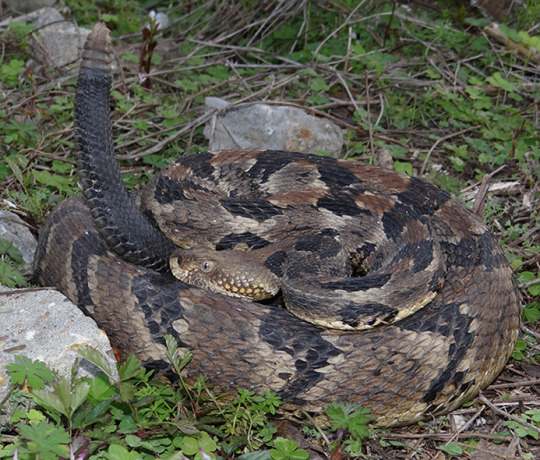
Rainbow boas! My favorite pet snake to keep! Beautiful and have such funny personalities.

Boa constrictors! Chill awesome dudes. A snake who you can hang out with.
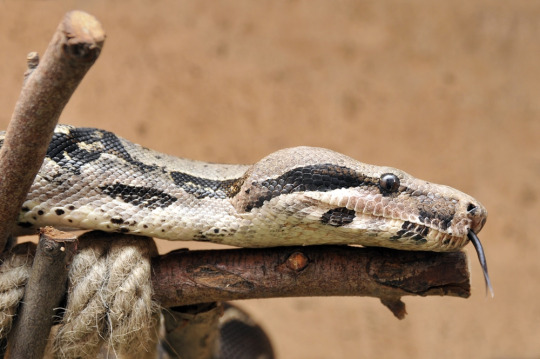
Sidewinders! The fastest snake in the world, and they look good while doing it!
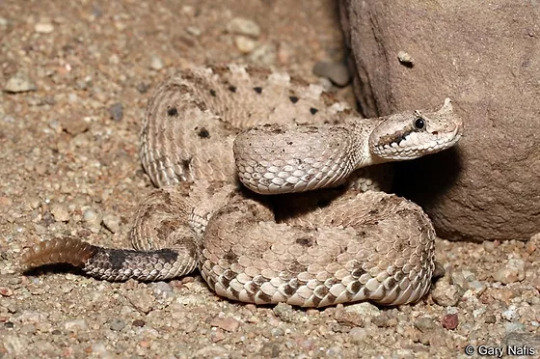
California kingsnakes. Pound-for-pound the strongest constrictors on the planet, and super cool to boot! Awesome pets, too.

Ball pythons! Come on. They're so cute! And they have such sweet personalities!

Stiletto snakes! Worked with these during my time in South Africa at the African Snakebite Institute and they gave me a heart attack every single day, they can bite you however you hold them so you have to wear special venom-proof gloves and it's still a heart-pounding experience. 10/10, no notes

Red-bellied black snakes! I've literally visited Australia solely to work with these guys.

Bush vipers! Some of the coolest looking snakes in the world! They're also cool to work with, not as snappy as other little vipers.
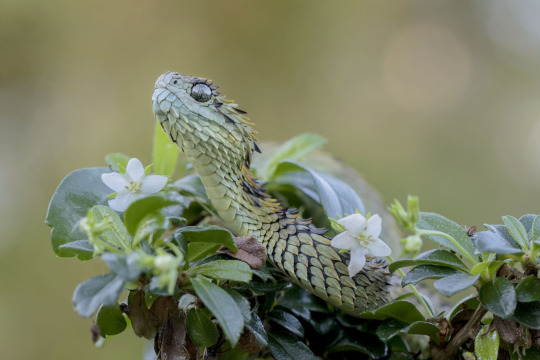
202 notes
·
View notes
Text
Introducing Moses - Exodus 1-4
Before I get into Exodus, I want to plug the podcast Biblical Baggage again. They did a great series on Moses/Exodus, so I'd highly recommend giving it a listen if you like this blog and listen to podcasts.
Israelites in Egypt - Exodus 1
Synopsis: After Joseph and his brothers died, the Israelites grew in numbers in Egypt. Then, a new Pharaoh came to rule in Egypt that didn't like the Israelites. The Pharaoh forced Israelites into slavery. Pharaoh ordered two of his midwives to kill all of the Israelite boys when they're born. They refused. When confronted, they said that "Hebrew women are not like Egyptian women; they are vigorous and give birth before the midwives arrive" (Exodus 1:19). The Israelites continued to grow in numbers. God blessed the midwives with families of their own.
There is about a 300-400 year gap between the stories of Joseph and Moses. Israelites/Jewish people have a long history of being persecuted. This is one of the earliest stories in their history that is a part of that. Although the veracity of the Exodus story is questioned by modern historians, there are parallels between this story and many other stories of oppression of Jewish people. This story was also significant for African-American slaves because they saw the parallels between their lives and this story. The story gave them hope that some day, they would be liberated like the Israelites were. The beginning of this story also has parallels to the beginning of Jesus' story.
Early Moses - Exodus 2
Synopsis: Moses was born to Levite (one of the tribes of Israel) parents. The parents hid Moses from Pharaoh for three months. Then, his mother placed him in a basket coated in tar and pitch and placed it in the reeds in the Nile. Pharaoh's daughter found the basket and had one of her slaves retrieve him. Pharaoh's daughter felt bad, so he told the slave to give him to a Hebrew woman for nursing. The slave ended up giving him back to his mother. When Moses grew up a bit more, Pharaoh's daughter took him back as her son. When Moses was a full adult, he went to watch the Israelites working. He saw an Egyptian abusing an Israelite, so he killed the Egyptian when nobody was looking. The next day, two Israelites were fighting, Moses asked why they were fighting each other, and the Israelites said, “Who made you ruler and judge over us? Are you thinking of killing me as you killed the Egyptian?” (Exodus 2:14). When Pharaoh heard what Moses did, he ordered for Moses to be killed, so Moses fled to Midian. Moses retrieved water for a family in Midian to help their flock. Then, he ended up marrying one of the daughters, Zipporah. Moses had a son, Gershom, with Zipporah. While Moses was away, the old Pharaoh died. Then, God heard the groaning of the Israelites, remembered his covenant with Jacob, and was concerned.
It's kind of confusing that Moses went from his parents, to Pharaoh's daughter, back to his parents, then finally back to Pharaoh's daughter. It'd probably be pretty tough for Moses to switch parents as often as he did. The Bible says that the name Moses is Hebrew for "drew out", but it is likely that the name is derived from the Egyptian word for son. Later, Moses tried to do a good thing by killing one of the Egyptians that was abusing the Israelites. In return, the Israelites hated him and he was chased out of Egypt because he was wanted for murder. Then, in typical God fashion, God allowed people to suffer for a long time before trying to do something to help. Fun fact, the name Sephora is derived from Moses' wife's name, Zipporah.
Moses and the Burning Bush - Exodus 3-4
Synopsis: Moses was tending a flock in Horeb when he saw a bush that was on fire, but not burning up. When Moses got closer, God told Moses to remove his sandals and that He was the God of his ancestors. God said that He'd heard the cries of the Israelites and that He is going to rescue them and return them to the Promised Land (a land flowing of milk and honey). To do this, Moses had to go and confront Pharaoh in Egypt. Moses didn't believe he's the right person for the job. God said that that He will work through Moses and that his name is Ehyeh (I am that I am). God told Moses to go to the elders of the Israelites and demand Pharaoh to let the Israelites go to the wilderness for 3 days of worship. God knew that Pharaoh will not let them go. He told Moses that he will strike the Egyptians, and then they will be able to leave with treasures and riches that the Egyptians will willingly hand over. God taught Moses how to turn his staff into a snake, how to turn his skin white and ashy, and how to turn water into blood so Moses can prove that God is working through him. Moses was concerned because he didn't speak well. God scolded Moses for doubting His power. Moses was still unsure, so God appointed Moses's brother to help Moses talk to the Egyptians. Moses left for Egypt with his family. God promised all the people who wanted him for murder were dead now. God ordered Moses to perform the signs for Pharaoh, but said that He is going to harden Pharaoh's heart. Then, Moses and Aaron met up and gathered the elders of Israel to explain God's plan.
Why was Moses' instinct to go toward a burning bush? Maybe I'm just a wimp, but my reaction would be to keep my distance and protect my herd. Horeb is believed to be the same place as Mount Sinai, which will become an important place later in the Bible. This scene was powerful and memorable for me in the Prince of Egypt. Great visuals, great dialogue, great music. Honestly, the "Promised Land" thing makes me uncomfy because of how modern Zionism treats the Palestinians and Manifest Destiny. Kicking people out of where they live is always tragic. God also foreshadows to Moses that Pharaoh will not give up easy and God will strike the Egyptians with plagues (SPOILERS: I don't like the plagues). Also, I hate God brainwashing people. Not only is it icky, but he doesn't even use it in a way where it would allow the Israelites to leave without a conflict. God teaches Moses magic tricks. That's cool. Ultimately though, the Israelites should never have been put in this situation by God. Exodus 4:24-26 is so strange and out of place, I didn't put it in the summary. It's about Zipporah cutting off her son's foreskin and rubbing it on Moses' feet to save Moses' son because Moses didn't keep the covenant of circumcision. Even scholars have a hard time interpreting this passage because some of the pronouns are vague. The beginning of Exodus was going pretty (in my opinion) well until that point.
Feel free to share your thoughts in the comments below or in the Discord. The passage for next Sunday will cover Moses and Aaron talking to Pharaoh before the plagues (Exodus 5-7:13).
3 notes
·
View notes
Text
9 REAL Curses That You Gotta Know About - Even If You’re Not Exploring An Ancient Egyptian Tomb This Weekend
It’s the 17th February 1923.
We are somewhere in Cairo, staving off the heat of an Egyptian Autumn.
We’re waiting. We’ve been waiting since 1915.
In a silent, swift moment the seal to Tutankhamun’s tomb is broken, and one of the most valuable pieces of history is finally passed to the hands of the historians.
But it wasn’t just the secrets of the past that were unleashed when the seal was broken.
Within 12 years, 8 of the explorers that accessed the tomb were dead. By taking their first steps into this place of rest they had unknowingly released what was to be known as the Curse of the Pharaohs.
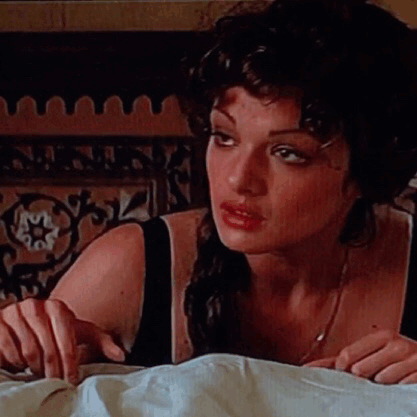
Ever since the 19th century British explorers first disturbed the pharaohs, a legend gained ground that claimed anyone who disturbed an Ancient Eypgtian mummy was to experience serious misfortune, illness, or even death.
And ever since they returned home with their spoils of the treasure was this claim proven correct, especially with the supposed curses detailed within the once hidden tombs themselves.
EDIT: Obviously this curse is founded more on the British media sensationalising exoticism, a common tactic of Imperialists in their racist agenda, so be far more wary of that than any old legend.
But what exactly was this curse? And were there any other curses that we should be aware of before we break into any other uncharted tombs?
What Exactly Is A Curse?
It’s founded some of our favourite urban legends and it is still used to stereotype certain communities - but it turns out that they’ve had this reputation for centuries.
In official terms, a curse is a wish that imposes adversity on a person or group of people, an object, or a place. Specifically, it is related to wishes made effective by supernatural circumstances, whether they’re enforced by spirits, or conjured via magic.
Regional divergences also exist, with jinxes belonging to African American Hoodoo, and hexing being a resident of Germany.
Convinced you’ve been cursed?
You have two options if you want to break the spell. One, you can either perform elaborate rituals specific to said-curse, or two, you can pray, like, a lot.
How helpful.

Not sure how you got cursed?
You’ve most likely encountered one of three things:
There’s the cursed objects - if you’ve been rooting through forbidden tombs or looted from a sanctuary, you might’ve brought a curse home, too. This curse typically amounts to bad luck, or the manifestation of strange phenomena.
Then there’s the curses from Ancient Egypt which are often associated with those that disturb mummies in their eternal slumber. The 19th century exploration of Pharaoh’s tombs revived this concept, and would allow the proliferation of our pop culture curses.
And then there's the Biblical curses. They don’t pause for breathe when cursing each other in the Bible, but thanks to my year 8 Religious Studies, I can tell you that at some point snakes and/or Cain was cursed.
(I’m sure Ms Comber would be ashamed knowing I can just about provide a tl;dr of the first few chapters of the Old Testament before the big plot twist.)
What Are The Most Famous Curses To Date?
#1 - The Curse of Tippecanoe
Our scene is set in 1931.
The brains behind Ripley’s Believe It Or Not - the bestselling publishers of unusual and slightly unnecessary facts - might not have much to report in the pre-internet age, but they were the first to note a rather peculiar trend:
American Presidents elected in a year ending in zero were to die whilst in office. This was later adapted to new, uh, data, which suggested years divisible by 20 (e.g. 1920, 1940, etc.) actually followed this trend.
And beyond the publishing date of this thesis in the early 20th century, this theory had been proven correct.
Think of an iconic president. You know, the ones that have changed history and haven’t suggested one consume bleach like shots of tequila on a two-night bender in ‘biza.

They’ve probably been a victim to this curse.
Lincoln. Mckinley. Roosevelt. Kennedy. Even Reagan and Bush followed the trend, but survived their own assassination attempts.
Question is, where does this curse supposedly come from?
William Harrison was killed only a month after being sworn into office. Elected in 1840, he waged war against a Native American tribe over problems concerning land ownership. Also known as Tecumseh’s War, this was a battle over an attempt to regain land against the American government, and it culminated in the Battle of Tippecanoe.
Harrison won this battle, and ‘Tippacanoe’ became a favoured nickname of the president.
However, shortly after the battle, one of the men at the fore of the Native American side cursed Harrison. We might not know the exact terms of this curse, nor if he wanted such a timely effect to take place, but with an election on the cards this year this thesis is due to be tested.
#2 - The Kennedy Curse
Kennedy might’ve already fallen victim to the curse of Tippacanoe, but it turns out that wasn’t quite enough. The thing is, this curse doesn’t necessarily affect just JFK. It affected everyone around him.
The Kennedy Curse allegedly prompted the deaths, accidents, and variety of other problems that have haunted the Kennedy family since before JFK even took office.
Due to the fact that some recent tragedies has supposedly been related to this curse, I’m going to refrain from coughing up each incident, but here’s a few to convince you:
Joseph Kennedy was the first victim in 1944, and died in a plane crash over Suffolk, England.
Kathleen Kennedy met a similar fate in 1948 after a plane crash.
Robert F Kennedy was killed on the night of his Senate victory in 1968.
David Kennedy died of a drug overdose in 1984.
Michael Kennedy died in a skiing accident in 1997.
John F Kennedy died in a plane crash in 1999.
Rosemary Kennedy had a lobotomy and was mentally incapacitated for the rest of her life until her death in 2005.
#3 - The 27 Club
The passing of young people is a tragedy we can’t quite wrap our heads around. Heck, belief in the supernatural is partially founded on how we can’t quite comprehend just losing someone, and that just being it.
Finality is an impossible concept to grasp.
And it’s why we turn to things like curses to explain away our pain and to make sense of it all. The 27 Club is a prime example of this.
A remarkable amount of the most famous musicians, artists, and actors to date have all died at the age of 27.
Like, over 50.
Jimi Hendrix, Janis Joplin, Amy Winehouse, Kurt Cobain, and Jim Morrison are just a few of the figures that represent the phenomenon, a phenomenon which has been referenced countless times in popular culture.
Some researchers may have disproven the alleged curse, but with the 4 founding members dying within a 2 year window (Brian Jones, Jimi Hendrix, Janis Joplin, and Jim Morrison), suspicions will always be roused.
#4 - The Curse of the Iceman
Popular culture phenomenons might form some of the most famous curses to date, but they really started with ancient legends. And this one is one of the most well-known claims of the awakening of a long-dormant curse.
Oetzi was found somewhere in the Alps in 1991.
No, this isn’t the name of some lovable character destined to have his own Netflix series; this is a corpse preserved by the icy temperatures of the mountain range in Italy. And this corpse is from 3100 or 3400 BC, or the Copper Age.

Given the value of this shocking discovery, numerous scientists took the fore in their investigation into Oetzi. But many of these scientists also died as a result of the supposed curse put on those that dare disturb Europe’s oldest natural mummy.
7 scientists that collaborated in the removal and examination of the corpse died in a suspiciously short window of time.
#5 - The Curse of Timur
Some of the world’s most famous curses have affected small groups of people. But this curse was a tad more far reaching.
Like 7.5-million-people-far-reaching.
Emperor Timur was a Turco-Mongol leader from the 14th century and established a highly impressive empire: the Timurid Empire. And this empire was so impressive that Stalin himself took direct inspiration from him.
That’s why he wanted the body of the emperor exhumed from his Uzbekistan tomb for investigation by Soviet anthropologists.
(There’s no explanation why, but the Soviet Union did many things we can’t explain.)
Locals protested, fearing a curse that reportedly started in 1740 when an Afsharid ruler took a slab from his final resting place to Persia. His son instantly fell ill amongst a host of other problems affecting his rule, prompting his advisors to convince him to return the slab of jade back to the tomb.
If the rumours weren’t enough to convince them not to break into the tomb, you’d think the warnings on there would do the trick:
"When I rise from the dead, the world shall tremble."
"Whomsoever opens my tomb shall unleash an invader more terrible than I."
Three days after the exhumation began, Hitler launched an operation that would figure as the largest military invasion on the Soviet Union to date.
#6 - The Superman Curse
Numerous films have been labelled with an alleged curse or a haunting. The Exorcist might be the most famous example of this - you know, with that severe fire burning down the set at one point - but a more specific curse can be attributed to those who played the lead in the Superman franchise.
George Reeves committed suicide in 1959.
Christopher Reeve became paralysed in 1985.
Lee Quigley died at 14 due to solvent abuse.
Kirk Alyn’s career met a dead end after his role.
Marlon Brando experienced a series of unfortunate events after his role.
Margot Kidder encountered serious issues with her mental health after her role.
Even the crew operating on the films experienced similar issues both on-set and in their personal lives.
#7 - The Hope Diamond Curse
It’s the most famous jewel in the world, weighing no less than 45 carats and passing between the hands of French kings and British bankers alike - but it’s value is far more supernatural than the $350m price tag.
It is said that a curse is attached to it, a curse that brings misfortune and accompanying tragedy to those that own or wear the gem.

Suicides, murders, executions (most of which were hangings), being ripped apart by wild dogs and various other mobs… Just wear the earrings next time.
Today it is on exhibit at the National Museum of Natural History in the US.
#8 - The Curse Of The Chicago Cubs
Bill Sianis lived an interesting life.
A Greek immigrant to the USA, he owned a tavern in Chicago affectionately named the Billy Goat Tavern. And it was this peculiar name that led to the curse that until recently haunted the Chicago Cubs.
Sianis took his pet goat to one of the games in 1945, a game that was a part of the World Series. But due to the odour of Murphy the Goat, he was asked to leave for the sake of the other fans.
“Them Cubs, they ain’t gonna win no more”
He declared this shortly after discovering that he would in fact have to leave.
This curse lasted 71 years, and mysteriously ended in 2016 after numerous attempts by fans to utilise rituals - mostly involving goats which may or may not be alive - to release the team from their magical confines.
Numerous goats have been brought to games with declarations claiming to reverse the curse being used, and even Sianis’ family members have done their bit in attempt to lift it. Yet despite these attempts - and that severed goat’s head sent personally to the owner in 2013 - some good has come from the curse.
Many charitable efforts have sprung forth from this legend, such as Reverse The Curse donating goats to those living in poverty in Third World countries.
#9 - The Curse of Turan
Now this is an interesting one.
Allegedly, the whole population of Hungary has been under a curse for many centuries, a curse that has two potential origins:
The first took place during the Christian conversion of the country in 1000 AD, from which those supporting the old religions of Hungary (Paganism and a mix of other minority religions) cast a curse that would affect Hungary for evermore…
(More… More… Mo...)
Or 1000 years, suggesting the curse might have been lifted already.
Alternatively, it could be a curse created or rumoured to exist during the failed revolution of 1848 which evoked a great sense of pessimism that is a reported symptom of the curse.
Although the previous curses mentioned in this article have a striking number of coincidences one can’t help be interested in, this one is a little, well, vague.
Sure, Hungary - like most countries - has experienced a number of tragedies over the last 1000 years, from the devastating impact of war and invasion, to foreign control, but how far can we pin suffering caused by imperialism on that of a curse?
The high suicide rate which ranks as 6th in the world might not point to a supernatural cause, but the rather darker reality of depression.
(Yeah, I agree, I should’ve finished this article on a cheerier note.)
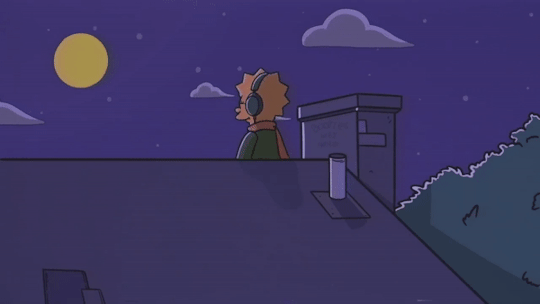
Well thank god that’s over!
Want to read stuff that’s less depressing and more delightfully spooky? ‘Course you do. Then go check out my other articles about all things horror and hauntings.
I even post a new real ghost story everyday.
Stay spooky!
#curse is real#curse#real curse#black magic#black magic curses#wiccan curse#bloody magic curses#curses#grand grimoire curse#real egyptian curses#ancient egypt#real ancient curses#chicago cubs curse#curse of the pharaohs#hope diamond#superman curse#the exorcist#the exorcist cursed#tutankhamun#tutankhamun curse#jfk#kennedy curse#tippecanoe#the iceman#bermuda triangle#Unexplained Mysteries#UNSOLVED MYSTERIES#unsolved crime#27 club#supernatural
23 notes
·
View notes
Text
Tagged by Tori @eddiekzpbrak I would die for you
Name: Rémy
Nickname: Rém , dumbass
Zodiac: Cancer sun and moon , Leo rising
Height: 5’2
Languages: English , dialect German , a bit of Hebrew and Yiddish
Nationality: Indigenous Australian
Favorite season: Winter
Favorite flower: I feel like my answer changes everytime ugsudsgsd but uh . Moon Flowers today because they come out at night and that’s metal as fuck
Favorite scent: The bush after it’s rained, cinnamon , peppermint
Favorite color: Any shade of blue or green except neons
Favorite animal: SPIDERS , saltwater crocodiles , african wild dogs (or like , any wild canine) , snakes , bats
Favorite fictional character: Any TOS Star Trek character , Mike Hanlon and Richie Tozier , Anduin Wrynn
Coffee, tea, or hot chocolate: Coffee
Average sleep: Between 3.5-4.5 hours lmao
Dog or cat: I prefer dogs , and I used to have one before she died , but cats are cute too and I think I’d make a good cat owner simply because I can shit out animal behaviorism facts fweugsduydfsfe
Blankets: One during summer that’s either my weighted blanket or a sheet if I absolutely cannot handle the heat , and two or three the rest of the year - one of those also being the weighted blanket
Dream trip: A massive trip to different natural sites across the world but especially mountainous areas or big fuckin forests , or like , any trip into those "high risk” travel areas such as Ukraine or fuckin . Turkmenistan .
Blog established: I’ve had so many url changes and a blog shift , but I started here in 2012 and I think I started this blog in 2013 or 2014
Followers: 945 because I lost a good handful to discourse and politics sduygdsusdff
Random fact about me: I feel like I overshare on this blog too much already , but uhh my favourite “movie” to watch as a kid or whatever was this little documentary about the savanna of Africa by the National Geographic , or the one about tigers . I watched those on repeat so many fucking times udfguyfdre
I’m tagging @trashzy @lopunny @ganon @eddsie @chutzpah-haver @edosian @rickrollers @frvitbatz and @thirty
12 notes
·
View notes
Text
U.S. Congressperson and former civil rights activist/organizer John Lewis was laid to rest today. His service took place at the historic Ebenezer Baptist Church in Atlanta, Georgia, U.S. The ministerial home of Dr. Martin Luther King Jr. in the 50s and 60s, Ebenezer has a long history with African people’s struggle for freedom and justice. That’s why its surreal that we find ourselves in a place today where someone like Bill Clinton can be welcomed into the pulpit at Ebenezer to offer an opinion on the correct path African people must take to achieve our forward progress. Clinton, of course, was the 42nd president of the U.S. empire. His claim to fame while being president was fooling scores of Africans into believing that he was our friend. It wasn’t until Obama was elected in 2008 that some African people stopped referring to Clinton as “our first Black president.” Underneath the superficial character presentation of Clinton existed a politician who built, along with his wife and many other opportunists a colossal industry based on imprisoning African people in this country. The Omnibus Crime bill, passed during Clinton’s tenure in 1994, proliferated incarceration rates, primarily of poor and African and/or Indigenous peoples, at record rates. And, yet, despite that clear legacy of harm caused against our people, we still invite someone like this to speak in one of our most storied and respected churches.
As a result, it should come as no surprise that Clinton used his opportunity to honor Lewis by taking a swipe at the legacy of Kwame Ture (Stokely Carmichael). Ture, was the organizer within the Student Non-Violent Coordinating Committee (SNCC) who unseated Lewis as chairperson of SNCC in 1966, thus signaling SNCC’s turn towards much more militant politics. In Clinton’s words, this nation is in such a better place because Lewis refused to continue within SNCC after “Stokely.”
Of course, the position advanced by Clinton should surprise no one who has studied the history of this man. And, it was ironic that Clinton reminisced during his Lewis speech about “being with Jesse Jackson” because it was Jackson who was at the center of one of Clinton’s first clear indications of what type of snake he really was. During his 1992 presidential campaign against George H.W. Bush (the first Bush president), Clinton used a traditional Southern Strategy race baiting tactic to call out Jesse Jackson, who at that time was considered one of the leading civil rights leaders in the U.S. Clinton did this by making a public reference to Jackson having some type of political comradery with then so-called “Blacktivist”, rapper, Sista Souljah who had made a name for herself by calling out white supremacy in uncompromising terms. Clinton, in a direct appeal to bourgeoisie voters, primarily European ones, attacked Jackson at that time as pandering to racist African militancy.
In some ways, what Clinton said today about Kwame Ture is a continuation of those politics of respectability and accommodation. That the only right way we could ever advance our struggle for justice is by adopting positions that did not challenge the very existence of the power structure. Instead, the “responsible” way to struggle is always that of waiting, being patient, and working within the very system that keeps us oppressed. Clinton’s comments were opportunistic and designed to send a message to our people at a time when the very foundation of this system is being questioned in many ways. Clinton’s message? Don’t stray too far away from the master. Stay within this system and you will be rewarded. Resist, and you will be punished. It would be hard to find much fundamental difference between what Clinton said today and what Trump says every-day. Plus, its highly doubtful that Lewis himself would have agreed with the characterization that Clinton gave regarding SNCC’s direction in 1966. Now, I doubt there is even 2% of what Lewis believed that I agree with, but one thing I do know is that even after an initial period of distance after that 1966 election, Lewis evolved to a place where he eventually had a positive relationship with Kwame Ture. He even came and participated directly in the dinner honoring Kwame’s life shortly before Kwame made his own physical transition back in 1997.
The bourgeoisie are the spokespersons for the international capitalist/Imperialist network which is led by the U.S. And, Clinton is undoubtedly a member of the bourgeoisie class. Every U.S. president is a member of this class, including Obama. Their roles after leaving the presidential office are to continue to advance the values of capitalism, which cannot happen without also advancing white supremacy, patriarchy, homophobia, and all the forms of injustice that capitalism thrives on. Obama does this routinely as does Clinton. Its their class responsibility. The bigger problem is that so many of us have no understanding of history, and no desire to have an understanding, that when these people distort our history, we don’t have the tools to effectively push back. For example, if someone was to say, as Clinton did today, that SNCC, under Kwame Ture’s leadership (and later Jamil Abdullah al-Amin, formally H. Rap Brown, and then Phil Hutchings), went downhill and Lewis left to preserve some level of dignity while those wild Africans ran the organization into the ground, it would be necessary for you to have the proper understanding of SNCC history to place Clinton’s comments in the garbage can where they belong. You can do that by understanding what happened to SNCC after Kwame became the chairperson of the organization. What happened is the launching of the most recent Black power movement. The bourgeoisie want you to define that era in the late sixties by the hundreds of urban rebellions, but we employ you not to back down from that challenge. Even Dr. King knew that urban rebellions are the voice of the voiceless. In other words, when people are in pain, they lash out. When a child touches a hot stove, they don’t start singing a song and playing. Urban rebellions are reflections of this system’s inability or desire to change oppressive conditions, so people lash out. If people don’t want people lashing out, care more about people unjustly losing their lives than you do about property being attacked as a result of this glaring human contradiction. Besides that, what SNCC actually accomplished through the Black power movement was a mass awakening that we as a people have the right to exist in a manner consistent with our values and culture, regardless of how European society feels or thinks about it. Without that movement, there would be no Black Lives Matter movement. There would probably be no LGBTQ movement or women’s movements. No physically challenged movement. All of those evolved as a result of the Black power movement. And, that developing consciousness led to SNCC taking a revolutionary position against the Vietnam war. In fact, as quiet as its kept, it was SNCC that led the smash the draft movement. They were the ones who popularized the saying “hell no, we won’t go!” (a Kwame classic), and they were the first national organization at the time (with respect to the Nation of Islam) to take a national position against zionism and in support of the Palestinian people. Clearly, all of those things have advanced and evolved to become mainstream elements of the social movements you are seeing in action today and none of this could be happening without the contributions of the more militant SNCC, led in party by Kwame Ture. So, clearly, there was no moral imperative to part “from Stokely” as Clinton implied in his boring and absurd comments earlier today.
2 notes
·
View notes
Text

Experts concerned young people’s mental health particularly hit by reality of the climate crisis
Over the past few weeks Clover Hogan has found herself crying during the day and waking up at night gripped by panic. The 20-year-old, who now lives in London, grew up in Queensland, Australia, cheek by jowl with the country’s wildlife, fishing frogs out of the toilet and dodging snakes hanging from the ceiling.
The bushfires ravaging her homeland over the past few weeks have taken their toll. “I’ve found myself bursting into tears … just seeing the absolutely harrowing images of what’s happening in Australia – it is overwhelming and terrifying.”
Hogan said her lowest point came when she heard about the death of half a billion animals incinerated as the fires swept through the bush. “That was the moment where I felt my heart cleave into two pieces. I felt absolutely distraught.”
The physical impact of the climate crisis is impossible to ignore, but experts are becoming increasingly concerned about another, less obvious consequence of the escalating emergency – the strain it is putting on people’s mental wellbeing, especially the young.
Psychologists warn that the impact can be debilitating for the growing number of people overwhelmed by the scientific reality of ecological breakdown and for those who have lived through traumatic climate events, often on the climate frontline in the global south.
Until two years ago Dr Patrick Kennedy-Williams, a clinical psychologist from Oxford, had spent his career treating common mental health difficulties including anxiety, depression and trauma. Then something new started to happen. Climate scientists and researchers working in Oxford began to approach him asking for help.
“These were people who were essentially facing a barrage of negative information and downward trends in their work … and the more they engaged with the issue, the more they realised what needed to be done – and the more they felt that was bigger than their capacity to enact meaningful change,” he said. “The consequences of this can be pretty dire – anxiety, burnout and a sort of professional paralysis.”
Kennedy-Williams began to research the topic and realised it was not just scientists and researchers who were suffering. “There is a huge need among parents, for instance, who are asking for support on how to talk to their kids about this.”
When Kennedy-Williams began focusing on young people he assumed most would be older teenagers or at least have started secondary school. But he soon discovered worrying levels of environment-related stress and anxiety in much younger children.
“What I was most surprised by is how young the awareness and anxiety starts. My own daughter was just six when she came to me and said: ‘Daddy, are we winning the war against climate change?’ and I was just flummoxed by that question in the moment. It really showed me the importance as a parent of being prepared for the conversation, so we can respond in a helpful way.”
He says there is no way to completely shield young people from the reality of the climate crisis, and argues that would be counterproductive even if it were possible. Rather, parents should talk to their children about their concerns and help them feel empowered to take action – however small – that can make a difference.
A key moment for Kennedy-Williams came with the realisation that tackling “climate anxiety” and tackling the climate crisis were intrinsically linked.
“The positive thing from our perspective as psychologists is that we soon realised the cure to climate anxiety is the same as the cure for climate change – action. It is about getting out and doing something that helps.
“Record and celebrate the changes you make. Nobody is too small. Make connections with other people and at the same time realise that you are not going to cure this problem on your own. This isn’t all on you and it’s not sustainable to be working on solving climate change 24/7.”
This certainly resonates with Hogan, who has set up Force of Nature, an initiative aimed at helping young people realise their potential to create change.
Hogan’s group aims to target people aged 11-24 with a crash course in the climate crisis that helps them navigate their anxiety and realise their potential to get involved, take action and make a stand.
“This is only the beginning,” said Hogan. “We’re going to see massive, massive widespread climate crisis in every country around the world, so it’s about developing the emotional resilience to carry on, but in a way that ignites really dramatic individual initiative.”
Beyond climate anxiety – the fear that the current system is pushing the Earth beyond its ecological limits – experts are also warning of a sharp rise in trauma caused by the experience of climate-related disasters.
In the global south, increasingly intense storms, wildfires, droughts and heatwaves have left their mark not just physically but also on the mental wellbeing of millions of people.

For Elizabeth Wathuti, a climate activist from Kenya, her experience of climate anxiety is not so much about the future but what is happening now. “People in African countries experience eco-anxiety differently because climate change for us is about the impacts that we are already experiencing now and the possibilities of the situation getting worse,” she said.
She works with young people through the Green Generation Initiative she founded and sees the effects of eco-anxiety first-hand. A common worry she hears among students is: “We won’t die of old age, we’ll die from climate change.”
Extreme climate events can create poverty, which exacerbates mental health problems, and Wathuti says she has seen stress, depression and alcohol and drug abuse as some of the side-effects of climate anxiety and trauma in her country.
Even in the UK, a recent study by the Environment Agency found that people who experience extreme weather such as storms or flooding are 50% more likely to suffer from mental health problems, including stress and depression, for years afterwards.
More than 1,000 clinical psychologists have signed an open letter highlighting the impact of the crisis on people’s wellbeing and predicting “acute trauma on a global scale in response to extreme weather events, forced migration and conflict”.
Kaaren Knight, a clinical psychologist who coordinated the letter, said: “The physical impacts related to extreme weather, food shortages and conflict are intertwined with the additional burden of mental health impacts and it is these psychologists are particularly concerned about.”
She added that fear and trauma “significantly reduced psychological wellbeing”, particularly in children. “This is of huge concern to us and needs to be part of the conversation when we talk about climate breakdown.”
One of the high-profile signatories of the letter, Prof Mike Wang, the chair of the Association of Clinical Psychologists UK, said: “Inaction and complacency are the privileges of yesterday … Psychologists are ready and willing to help countries protect the health and wellbeing of their citizens given the inevitable social and psychological consequences of climate change.”
This rallying of the psychological profession around the climate crisis has led to experts around the world forming groups to research and treat the growing number of people caught up in the unfolding crisis, attempting to help them move from fear and paralysis towards action.
But even for those who are following this advice, the scale of the emergency is taking its toll. Kennedy Williams – who has set up his own group, Climate Psychologists, specialising in climate anxiety – said he and his colleagues were not immune from the psychological impacts of the crisis.
“This is such a universal thing that [we] have all been through our own set of climate-related grief and despair, and we talk about riding the wave between hope and despair … it is absolutely as real for us as it is for anyone else.”
Advice for parents
Remember that you do not need to be a climate expert It’s OK to explore learning together. If your child asks a question you can’t answer immediately, respond by saying: “What a great question. Let me look into that so I can answer it properly.”
Try to validate, rather than minimise, children’s emotions If children express anxiety, it’s much better to say: “It’s OK to feel worried. Here is what we can do about it,” than to say: “Don’t worry. It’s all fine.” But always try to support this emotion with suggestions for positive action.
Negative information hits harder Bad or threatening facts tend to resonate more strongly – and therefore stick in the mind. So try to balance one piece of negative news with three pieces of positive news. Have some examples of good climate-related news ready – for example, successful conservation projects.
For younger children, keep it local and tangible Suggest litter picks and school events. For teenagers, encourage them to stay connected at a wider level – help them write to their MP, take part in protests and join local communities and campaigns.
Set practical goals as a family and follow through Record and celebrate your climate successes together (even a piece of paper on the fridge door). Reinforce the message that small actions can make a big difference.
#science#climate change#environment#psychology#anxitey#climate crisis#climate#climate change anxiety
5 notes
·
View notes
Text
Variable Bush Viper

Atheris squamigera

Countries: Angola, Benin, Cameroon, Central African Republic, Democratic Republic of the Congo, Equatorial Guinea, Gabon, Ghana, Kenya, Nigeria, Republic of Congo, Togo, Uganda
Interesting facts: 🔔 It inhabits mostly rainforest, preferring relatively low and thick flowering bushes.
🔔 It is nocturnal and like other vipers is an ambush predator.
🔔 Compared with most other snake species, it has relatively large eyes.
2 notes
·
View notes
Text
Dust Volume 5, No. 1

Idris Ackamoor and the Pyramids
Our first Dust of the year ties up loose ends from 2018 with several of our writers using the holiday break to rip through big piles of neglected discs, find the good and the great and share their observations. It’s an impressive haul with a little something for everyone from fusion-y Afro-jazz to twin guitar reveries (played by actual twins) to improvised percussion to a fascinating bandleader who reminds us of everyone and no one. This edition’s contributors included Bill Meyer (who wins this round), Isaac Olson, Derek Taylor, Patrick Masterson, Jennifer Kelly and Jonathan Shaw. Happy new year.
Idris Ackamoor and the Pyramids — An Angel Fell (Strut)
An Angel Fell by Idris Ackamoor and the Pyramids
What makes An Angel Fell, the latest from Idris Ackamoor and his resurrected Pyramids, such a blast is how effortlessly they mix Afrobeat, Afro-Cuban, dub, free jazz, blues, soul, gospel, bossa nova, and Arkestral vocals without sounding like a pastiche. What makes it important is that this inclusive, post-everything musical approach is married to an equally inclusive and utopian political sensibility: inclusive in the sense that sci-fi parables are given a seat at the table next to real world concerns, and utopian in the sense that the mystical Afrofuturism of songs like “An Angel Fell” and goofy exotica of “Papyrus” never trivialize the album highlight, “Soliloquy for Michael Brown,” which, despite its name, includes the whole damn band. Most importantly, it’s inclusive in the sense that Ackamoor and company want you marching and dancing with them, and utopian in that they whipped up a joyous hour and seven minutes of scorching solos, arresting hooks, and straight fire to get you there.
Isaac Olson
Anna & Elizabeth — The Invisible Comes To US (Smithsonian Folkways Recordings)
youtube
Ann Roberts-Gevalt and Elizabeth LaPrelle have used backlit, hand-cranked scrolls to illustrate the stories they rendered with Appalachian harmonies and strings. On their third album, The Invisible Comes to Us, they reframe their tradition-steeped sound with retro-futurist instrumentation supplied by producer and multi-instrumentalist Benjamin Lazar Davis of Cuddle Magic and accompanists such as drummer Jim White (Xylouris White, Dirty Three) and steel guitarist Susan Alcorn. Vocoders, feedback, brass and Mellotron keep the sound varied and far from by-the-numbers folk, but the duo don’t tamper much with their impassive presentation of Civil War-vintage infidelity. It’s hard to shake the suspicion that the duo could have made just as strong an album with just their voices and strings, but that doesn’t keep this from being an intriguing advancement of the evolving folk music paradigm.
Bill Meyer
Martin Blume / Wilbert de Joode / John Butcher — Low Yellow (Jazzwerkstatt)
youtube
The title of this trio recording is a bit of a stumper. When the CD is playing words like “bright,” “acute” and “mercurial” come more quickly to mind than “low” or any single color. German drummer Martin Blume, Dutch bassist Wilbert de Joode and English saxophonist John Butcher have been playing together since 2004, and this live set from 2016 is a splendid example of the aesthetic and methodological rapport that can evolve over such a span. These men might not know exactly what they’re going to do when they get on stage, but it’s pretty clear what they are doing. They improvise with an exacting attention to process that allows a music to come into existence that would not be possible if you swapped any player for another, yet never involves one musician dominating the others. Each has a highly distinct musical vocabulary and sufficient differences in background for the music to surprise in deeply satisfying ways.
Bill Meyer
Bixiga 70 — Quebra Cabeça (Glitterbeat)
Quebra Cabeça by Bixiga 70
Quebra Cabeça means jigsaw puzzle in Portuguese, and this latest double LP from the Afro-Brazilian ten-piece certainly fits a lot of pieces together here — rattling barrio percussion, twitchy Lagos-funked guitars, 1970s American blaxploitation soundtracks, space-age synths and swaggering sax and brass frontlines. If it sounds like too many parts, that’s where you’re wrong. Cuts like “Pedra de Raio” integrate the mystic chill of trippy fusion with a molten throb of samba rhythm. An effortless propulsion of hand drums, bumping bass and warm West African guitars moves the cut forward; serpentine sax melodies and blurts of brass jut off from the foundation. “Levante” syncopates, but slowly, with undulating, Eastern-toned sax lines weaving snake dances over it all. “Torre” picks up the pace from there, leaning into its Afro-funk influences with an agitated tangle of trebly guitars, cow-bells and blasts of horns. None of these pieces are jammed in willy-nilly, and everything fits. If you like the Budos Band, but wish they’d do a Fela tribute, this is your jam.
Jennifer Kelly
East of the Valley Blues — Ressemblera (Astral Spirits)
Ressemblera by East of the Valley Blues
Cryptophasia, a.k.a twinspeak, is the phenomenon of twins developing a language of their own, largely or entirely unintelligible to outsiders. East of the Valley Blues, comprised of Andrew and Patrick Cahill, is a twin guitar group, which is to say, they each play guitar and are literally twins, and while their knotty, wholly improvised fourth release, Ressemblera, isn’t entirely cryptophasic, you’ll need to listen closely to start piecing it together. Grab a pair of headphones and you get a brother in each ear, which helps. So suddenly do the brothers Cahill pick up, break off and drop shards of rhythm and melody that Ressemblera never resembles other guitar music but their own for more than seconds at a time. You’ll hear snatches of Fahey, Connors, Bailey et al. but the fun of Ressemblera comes from hearing familiar sounds doubly refracted through the Cahill’s unique styles and responses to each other. Ressemblera plays out in one, dense half hour track and a short epilogue, making it the least accessible East of the Valley Blues release to date, but for those willing to dive in, it might be the most rewarding.
Isaac Olson
Flanger Magazine — Breslin (Sophomore Lounge)
FLANGER MAGAZINE "Breslin" by Flanger Magazine
Remember Caboladies? For a few years back at the height of the synth resurgence, they kept up a respectable stream of squelchy sound, only to disappear like memories of Myspace. It would appear that Christopher David Bush of Caboladies has taken a path somewhat akin to that navigated by laptop rockers who swapped their Macs for modular synths; go back, man, peel back the generations of gear. The digital sheen’s gone from his solo music as Flanger Magazine, replaced by an unenhanced analog vibe generated by acoustic guitar, monophonic synthesizer, and field recordings of birds that bath near the Ohio River. Instead of the audio expanse of yore, he crafts shy and pensive themes that would be just about right for that PBS afternoon drama you dreamed up after a few too many mid-day snacks about the adventures of some long-haired Scottish mid-teens in already-outgrown flare-legged pants their friends the runaway redundant robots. Damn, that was a good dream.
Bill Meyer
Fred Frith Trio – Closer to the Ground (Intakt)
Closer to the Ground by Fred Frith Trio
Rigorously resisting complacency and conformity across stacked decades can carry the consequences of burnout for even the most ardent and resilient of creative musicians. Closer to the Ground is evidence of guitarist Fred Frith coming to terms with this fact and realizing with renewed vigor the pleasures of playing in a band. Ensemble endeavors have been a regular outlet since his youth and while the measure of their enduring value is no epiphany, the company of bassist Jason Hoopes (fielding both acoustic and electric strings) and drummer Jordan Glenn has an obvious and immediate effect of dialing in the guitarist’s mercurial and explosive side. Both sidemen are mere fractions of the Frith’s age, but each is quick to illustrate that when levied against ardor and experience any differential is just a number. Grooves are plentiful, mixing prog rock atmospherics, dub and latticed drones with a flexing, propulsive sense of consensual purpose. Frith syncs his strings to all manner of filters and pigments, refusing to hew to any enduring signature and his partners respond with a similarly colorful palette of support. Titles for the nine pieces are all evocative, but in the end its the assembled aqueous sounds that adhere to the space between the ears above all else.
Derek Taylor
Fritz Hauser – Laboratorio (hat[now]ART)

The lede to the liners accompanying Fritz Hauser’s Laboratorio is “Drums and Space,” as an accurate and pithy a synopsis of the Swiss percussionist’s art as a curious neophyte listener could ask for. Hauser’s been active as a Contemporary Classical composer for much of his career, constructing complex music that draws on all manner of drum family devices. He’s also devoted time to associations with world-class improvisers including Joe McPhee and Jöelle Léandre. Here, the focus is on solo pieces devised around the nexus of music and architecture with inspiration provided by students of the latter. As with past Hauser projects the organized sounds are exacting. Identified only by a sequential Italian number, each piece explores facets of his assembled kit (snare, toms, cymbals, woodblocks, etc.) and how those components interact and refract within the crystalline acoustics of the recording space. Ranging from ghostly metallic whispers to strident tumbling rhythms the revolving parts create a recital rich with diaphanous dynamics and precision pivots in direction. Hauser’s an unassuming master of his craft and this hours’ worth of drum-driven dramaturgy delivers on nearly every count.
Derek Taylor
Sarah Hennies / Greg Stuart — Rundle (Notice Recordings)
Rundle by Sarah Hennies & Greg Stuart
A few years back Sarah Hennies released an album called Work. While that was a solo CD of composed music, and this is an improvised collaboration between Hennies and fellow percussionist Greg Stuart (who, along with Tim Feeney, comprise the trio Meridian), the title comes to mind when listening to this cassette. For while both musicians are well acquainted with realizing profound, provocative and beautiful works by Michael Pisaro, Clara de Asis and Hennies herself, the vibe here is “let’s get to work.” The two musicians approach the assembled resources of the Banff Centre for the Arts and Creativity like a couple of tradespeople sizing up a tool shop. “What do you have here?” “What can I do with this?” “What shall we build?” Moving decisively between hard objects, scraped surfaces and hovering mallet and piano figures, they construct an edifice of sound rich in tonal and temporal contrasts. Nice work.
Bill Meyer
MP Hopkins — G.R/S.S (Aussenraum)
MP Hopkins is a both sides of the coin kind of guy. Heads, you get abbreviation.
G.R stands for “The Gallery Rounds” and S.S for “Scratchy Sentence.” Tales, you get elongation. Each of those pieces lasts a side, and each side is an unhurried investigation of the sounds that happen when not much happens. The first is a collection of degraded field recordings of forced air ventilation, not-quite-heard conversations and other stuff you aren’t supposed to notice when you check out some art. “Scratchy Sentence” is the outcome of Hopkins’ struggle to get something out of some synthesizers he didn’t really know how to use, which he compares to the task of coaxing conversation from a grumpy old man. The old man might say, “well if you learned how I talk, I’d sing!” It’s true, but who is holding classes on the lingo of old EMS and Arp machines? You learn as you go, and the discoveries that you make during that early struggle just might yield some cool sounds. That is the case here.
Bill Meyer
Sarah Longfield — Disparity (Season of Mist)
youtube
Sarah Longfield can shred — but is that enough? Maybe it is, in a field of music that’s as hyperbolically dude-centric as virtuoso-level rock guitar. Steve Vai, Yngwie Malmsteen, the fellows in Animals as Leaders: there’s little restraint in their compositions or performative styles, which feature as much groin-focused acrobatics as tapping harmonics. So, it’s sort of refreshing to watch Longfield do her thing. She plays. Occasionally she nods her head. Much of her music is as overstuffed as the spiraling, wanking, proggy nonsense that acts like Animals as Leaders churn out. But Longfield’s understated presence and her emotionally poignant vocals keep the songs grounded, if a bit mannerly.
Jonathan Shaw
Richard Papiercuts — Twisting the Night (Ever/Never)
Twisting The Night by Richard Papiercuts
Richard Papiercuts sings in a gothy baritone, tossing off mordant asides like a 1930s movie star. That is, he’s somewhere in the Venn Diagram where the dank glamor of Bauhaus intersects with the Monochrome Set’s fey wit (it’s a very small slice). To add to the complications, his band is large, multi-instrumented and exuberant, prone to happy squalls of guitar and irresistible blurts of brass and saxophone, but also clearly aligned with punk rock’s brevity and punch. (Think Olivia Tremor Control playing Minutemen covers.) And so, it is very hard to get a handle on Richard Papiercuts, much less to box him in with reference and antecedents, but it is much easier to say fuck it all and just dive in. You can start at the beginning with “A Place to Stay,” a walloping beat galloping between big slashes of guitars, and Papiercuts singing archly about (I think) having a baby. Or move right to the ebullient roar of distorted guitars in “Starless Summer Night,” where a rackety, endlessly repeated groove recalls rave-y shoegaze bands like Chapterhouse. “The Riddle” sounds exactly like the Pixies until it doesn’t, that is until its grinding bass and incandescent guitar gives way to a joyful overload of jangling strings, banged piano keys and loopy riffs of trombone and sax. “World and Not World (Twisting the Night)” begins in a pinging new wave synth, which is subsumed not much later by a rushing krautish momentum. And over it all Papiercuts presides, morose, poetic, disdainful and stylish. If rock stars still roamed the earth, he’d be one.
Jennifer Kelly
Dane Rousay — Neuter cassette (Dane Rousay)
Neuter by Dane Rousay
The cassette’s case is pink. The playing is decisive and attentive to contrast, but also reserved. The title cancels gender, and by implication conventionally binary readings of just what a solo drum performance is about. Dane Rousay’s latest recording highlights the communicative power of orchestrated gestures. Each strike, scrape or roll not only fills up space, but asks you to think about the point of that sound manifesting in that space for as long as it is around and as long as you think about it. That’s not just a solo percussion tape you’re hearing; that’s existential expression.
Bill Meyer
Kenny Segal — Happy Little Trees (Ruby Yacht)
happy little trees by Kenny Segal
For a guy who’s fallen asleep to full-length Bob Ross episodes for years now (ask me about the days when I had to navigate endless hazardous popups on this one Chinese streaming site before the Rawse estate finally brought the whole series to YouTube), I really let myself down not investigating Kenny Segal’s Happy Little Trees closer to its mid-October release. The L.A. beatsmith, who made his name at Concrete Jungle playing drum n’ bass, has done work for Busdriver, Open Mike Eagle and collaborated with Milo, but he’s on his own here painting rhythms into the wilderness of your mind’s imagination sure to satisfy both the ASMR devotee in your life and that person who has fallen down the rabbit hole of Spotify chill mixes and cannot be retrieved. Featuring instrumental assistance including guitars, bass, sax, flute and piano from a tight cohort of co-conspirators, you’ll likely know where you stand based on the title of the seventh track alone: “Adultswimtypebeat.” Come, let’s make some big decisions together.
Patrick Masterson
Howard Stelzer — Across The Blazer (Marginal Frequency)
MFCD C | Across the Blazer by Howard Stelzer
The two tracks on Across the Blazer are founded upon a device beloved by sound designers. The Shepard Tone comprises three looped sine tones that are selectively faded to create the impression of an endlessly rising pitch. Imagine pitching a tent inside one of George Martin’s tape creations from “A Day in the Life” and spending the night while it never ends, and you’ve got an idea of what listening to this CD will do to you. It simultaneously instigates the apprehension that something is going to happen and the experience of nothing happening. Stelzer creates this experience with carefully filtered cassette tape noise, but the tools don’t really matter. It’s the vividness of the experience, which is enhanced by the halo-like masslessness of this enveloping sound, that counts.
Bill Meyer
Szun Waves — New Hymn to Freedom (Leaf)
New Hymn To Freedom by Szun Waves
Much of New Hymn to Freedom, the latest by Szun Waves, a free improv drums, sax and electronics trio tangentially related to that booming jazz scene in London you’ve been hearing so much about, is the burbling and exhilarating aural equivalent of the (in)famous “Star Gate” sequence in 2001: A Space Odyssey, except there’s a younger, more hopeful version of yourself at the end of the tunnel. But the best tracks on New Hymn To Freedom, the gorgeous, nocturnal “Fall Into the Water” and the melancholy, swinging “Temple”, are grounded and restrained. It’s as easy to imagine them playing as you lay on the hood of your car as it is piloting yourself through the cosmos.
Isaac Olson
Terre Thaemlitz — Comp x Comp (Comatonse Recordings)
Comp x Comp by Terre Thaemlitz
Anyone too lazy (or naïve) to investigate the mammoth back catalog of producer, poet, queer theorist and all around champion of the disenfranchised Terre Thaemlitz beyond the canonized DJ Sprinkles release Midtown 120 Blues has been gifted something special as 2019 dawns: Thaemlitz’s Comatonse Recordings made its way to Bandcamp in early January with a hodgepodge of albums that, as she puts it, “I have sold out of, but there is not enough interest for a physical repress.” Among these releases – which include 1995’s organic Soil and 1999’s bait-and-switch-campaigned Love for Sale: Taking Stock in Our Pride – is something especially noteworthy, Comp x Comp. The 76-track album is, as its title would suggest, a compilation of minimalist glitch, noise, ambient and nigh orchestral pieces that largely eschew dancefloor adrenaline. A series of 10 disorienting audio shorts each around a half-minute, "Mille Glaces.000-009," will intrigue Mille Plateaux completists deprived of a chance to hear it when the label went bankrupt in ’03, but there are also proper tracks like the 11-minute “Get in and Drive” and “A Quiet of Intimacy Mirrors Distance.” Thaemlitz’s idea of filling out the remainder of a CD length with 47 mostly silent one-second tracks occupies much of the tracklisting, but don’t be fooled: You’re getting your 80 minutes’ worth… and not a second more or less.
Patrick Masterson
Mike Westbrook — Starcross Bridge (Hatology)
youtube
As befits a man known best as a big band leader, Mike Westbrook has not made many solo records. This is only his third in 43 years, and it freely references things and people who have passed. Aged 81 when he recorded it in December 2017, Westbrook has seen a lot. He’s old enough to remember World War II and the drabness of postwar England; old enough to have been persuaded first hand of swing and modern jazz’s life-giving inspirations; to have seen his band-mates experiment there way into free improvisation while the world went nuts for the Beatles; and to have seen his generation inevitably pass the world on to the ill-gripping paws that have dubious hold of it now. You can hear bits of all of that across this album’s 14 tracks, as well as more personal memories. Cherished favorites by Duke Ellington and Thelonious Monk bump up against pop tunes that he played with his wife Kate, and a couple originals are dedicated to musicians who played in his band but are no longer with us. Each performance feels as well framed as a remembered story, the one that you tell over and over to keep that memory alive.
Bill Meyer
Woven Skull — S/T (Oaken Palace)
Woven Skull by Woven Skull
Ireland’s Woven Skull has a few neat tricks up their sleeve: they use drums, viola, mandola and whatever else is laying around, to whip up furious, black metal-esque squalls and eerie folk hauntings. They harness roiling free improv to mantric repetition and pentatonic, vaguely north African motifs. They mimic (and insert) the sounds of the bogs that surround their home base in Leitrim into their headier jams and, like their spiritual forbears Sun City Girls, they’ve got a penchant for homemade, bike bell gamelan. However, Woven Skull’s greatest trick is convincing you, for as long as they’re playing, that they’re the greatest band in the world. More serious than Sun City Girls and more playful than Bardo Pond, Woven Skull is a great introduction to your new favorite cult band.
Isaac Olson
#dust#dusted magazine#idris ackamoor#anna and elizabeth#isaac olson#bill meyer#martin blume#wilbert de joode#john butcher#bixiga 70#jennifer kelly#east of the valley blues#flanger magazine#fred frith#derek taylor#fritz hauser#sarah hennies#greg stuart#mp hopkins#sarah longfield#jonathan shaw#richard papiercuts#dana rousay#kenny segal#patrick masterson#howard stelzer#szun waves#terre thaemlitz#mike westbrook#woven skull
10 notes
·
View notes